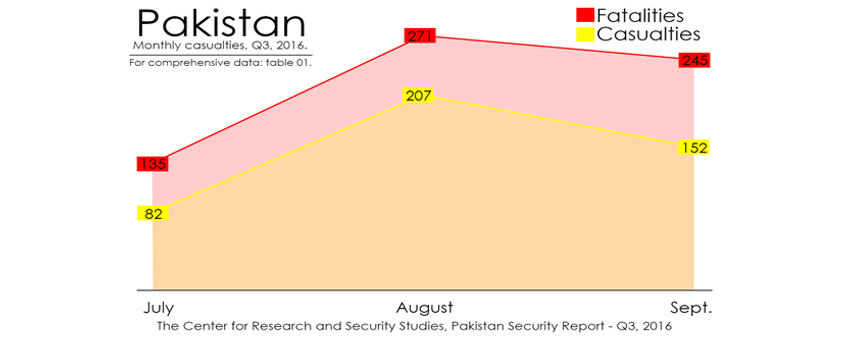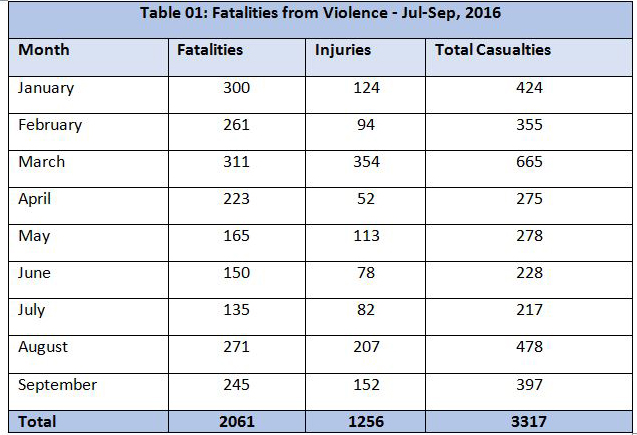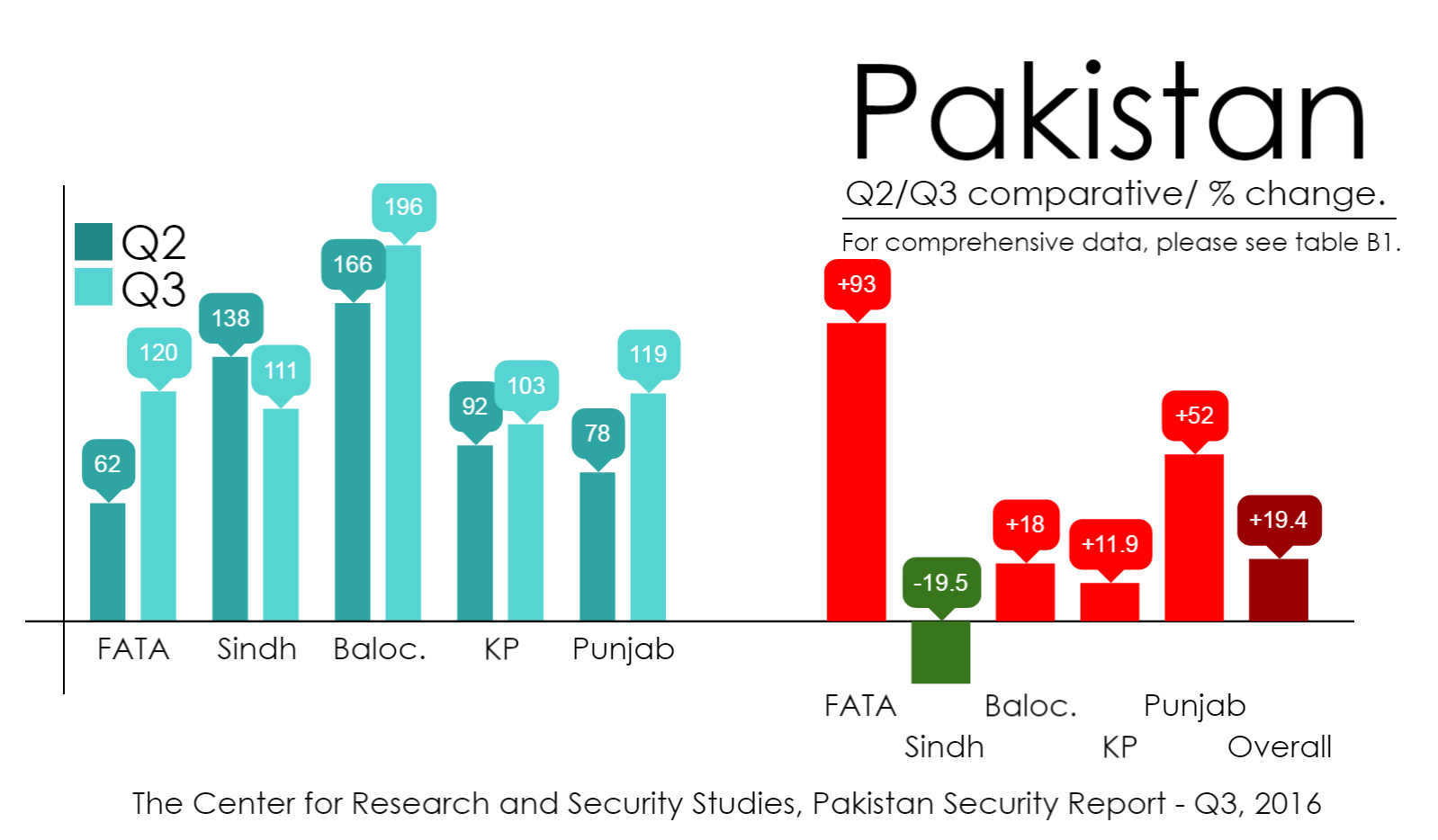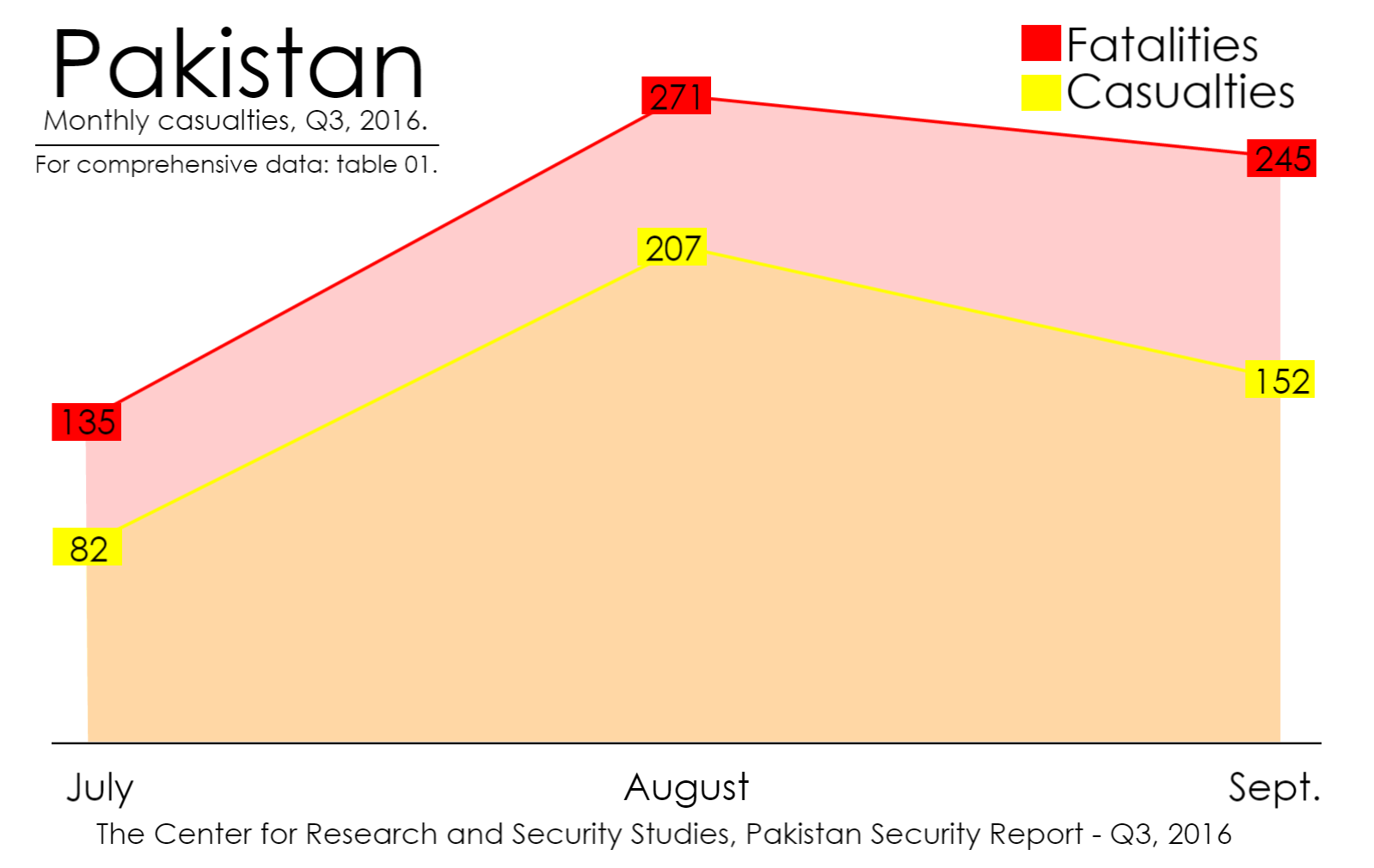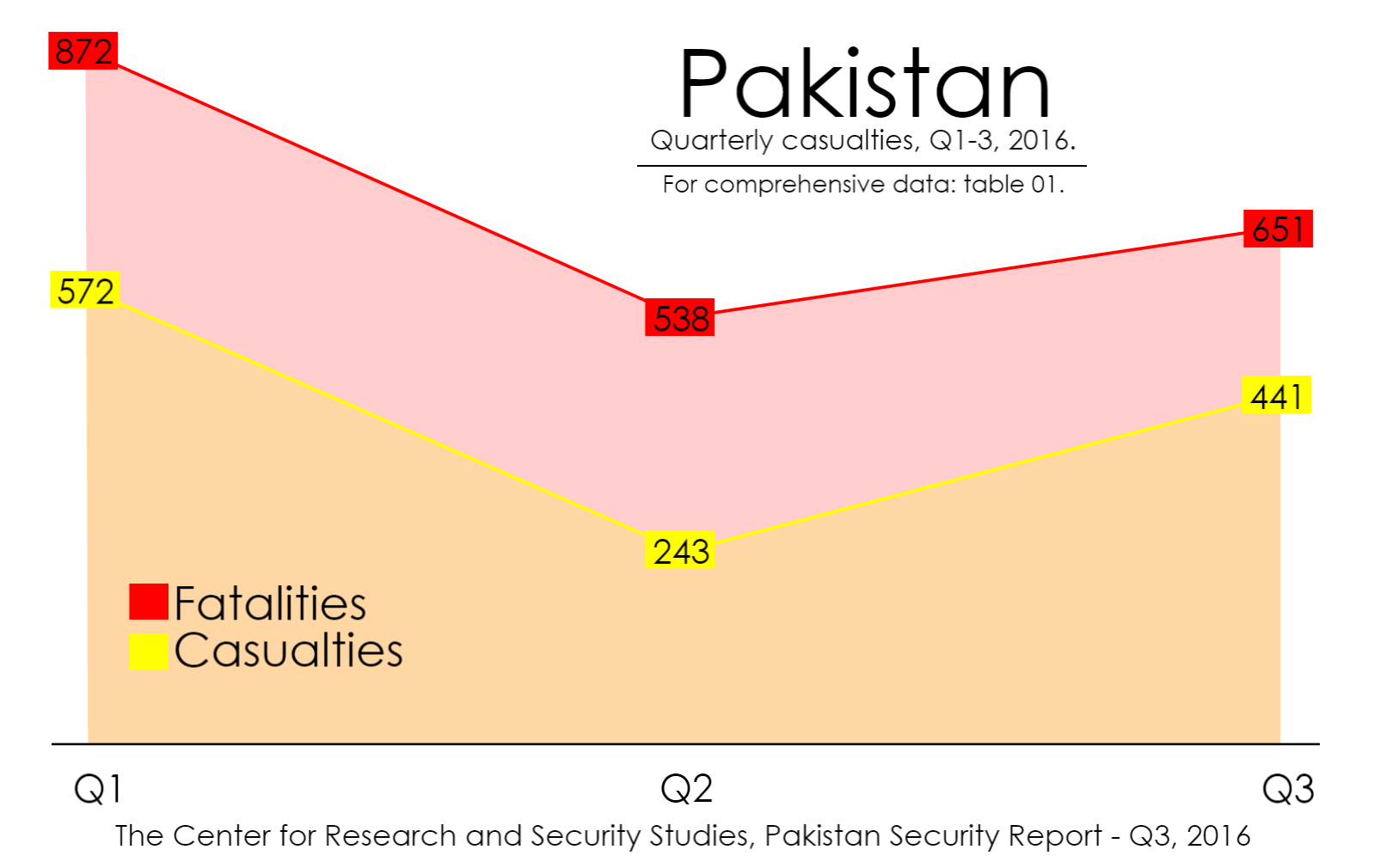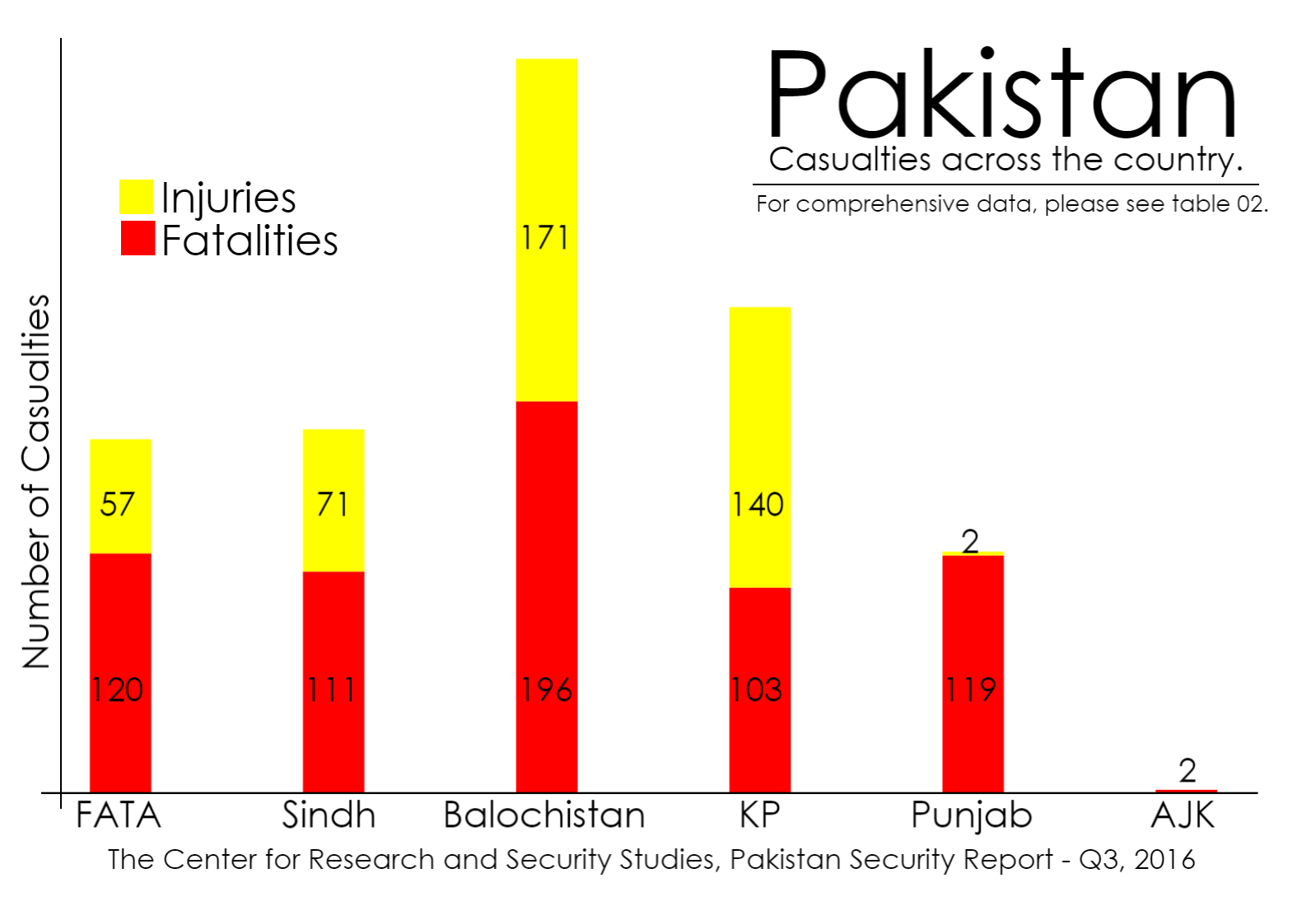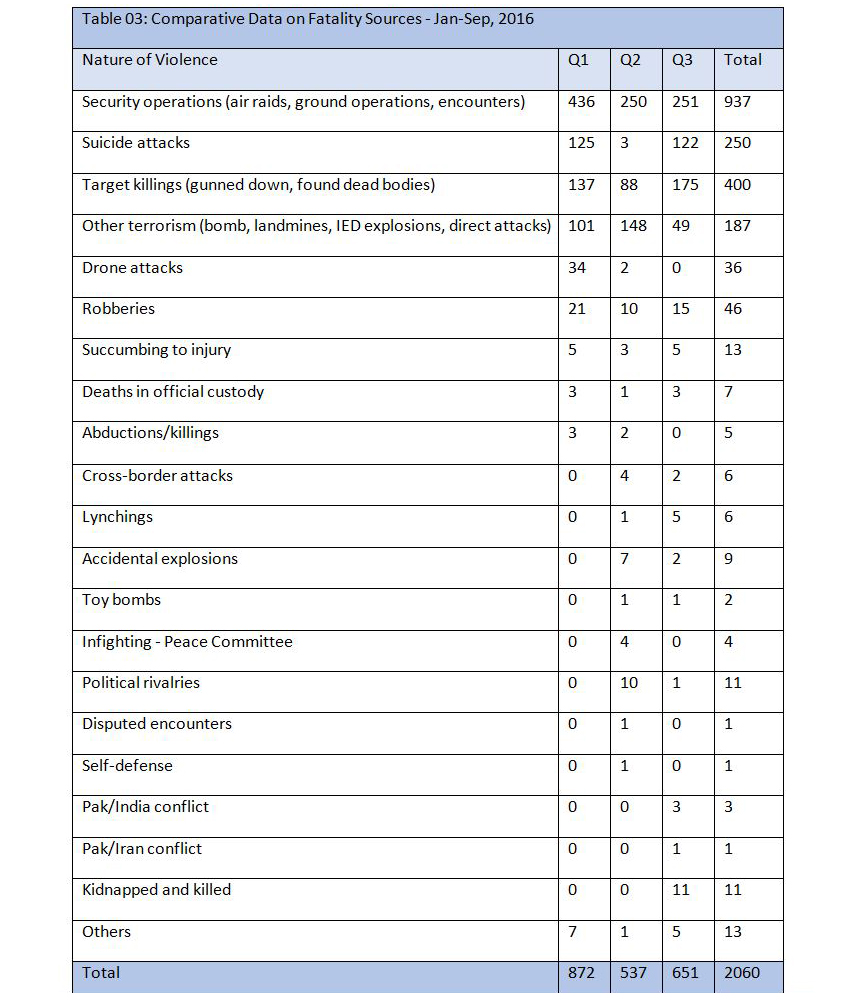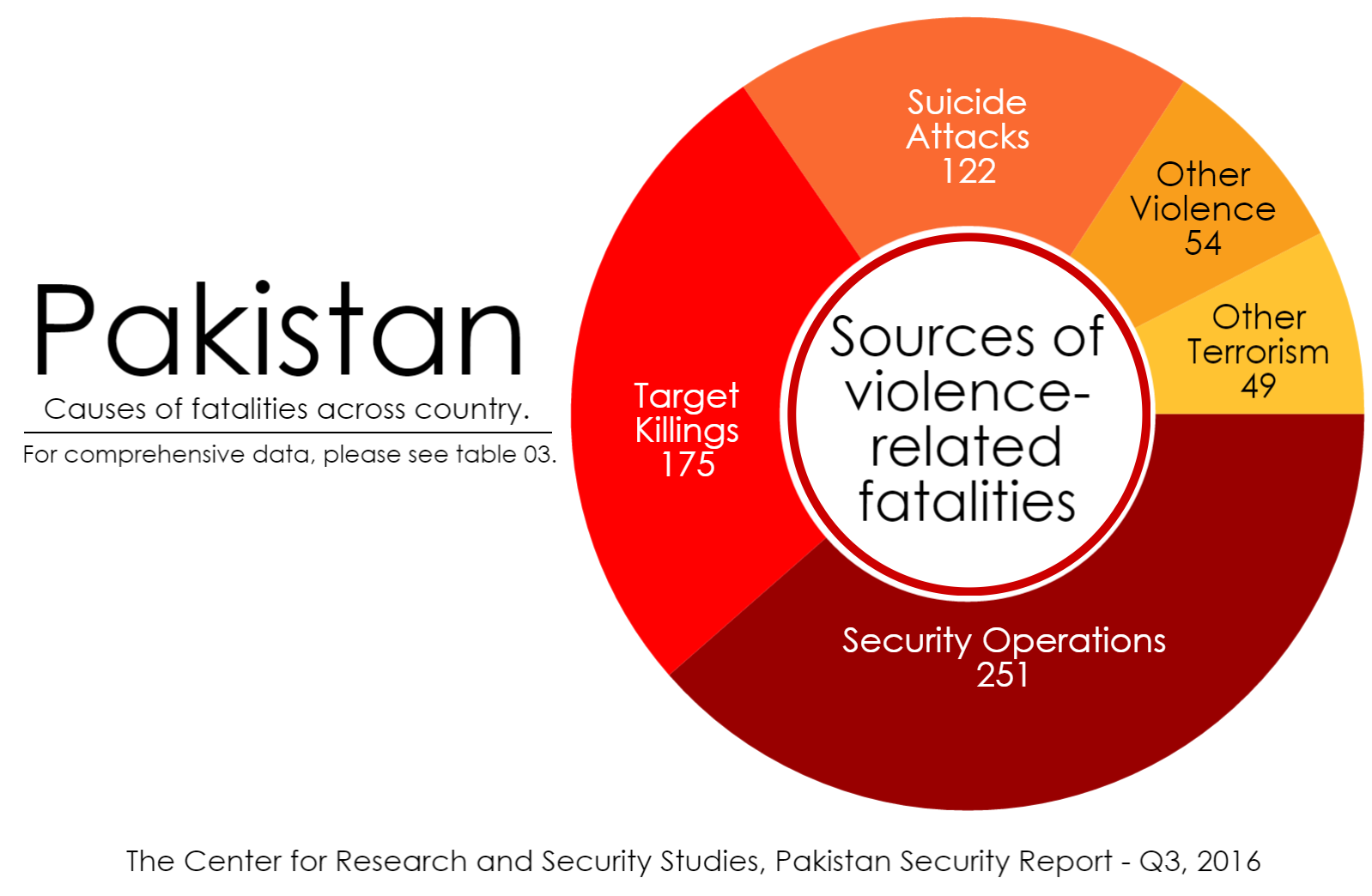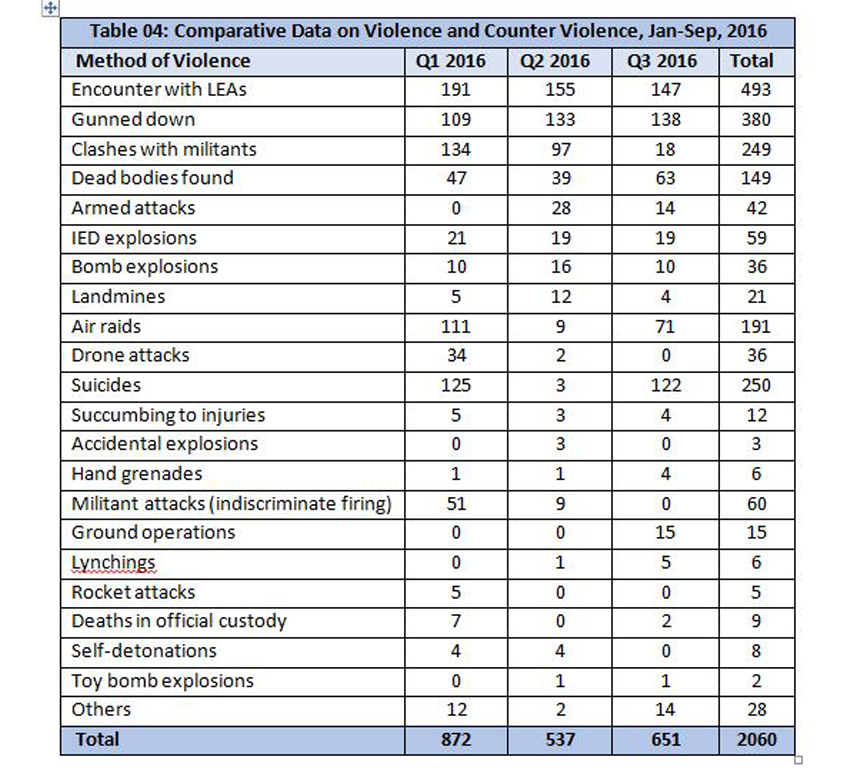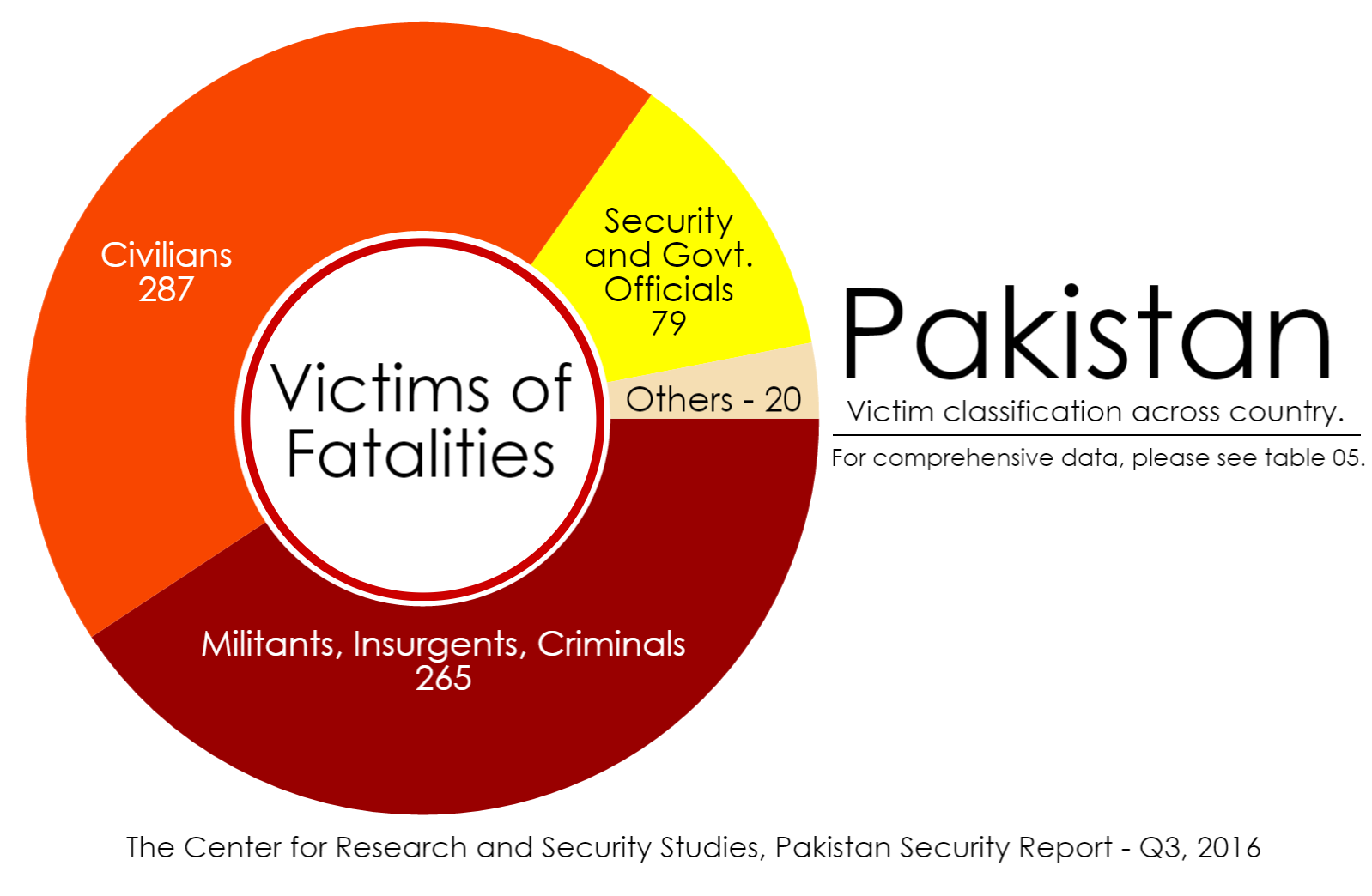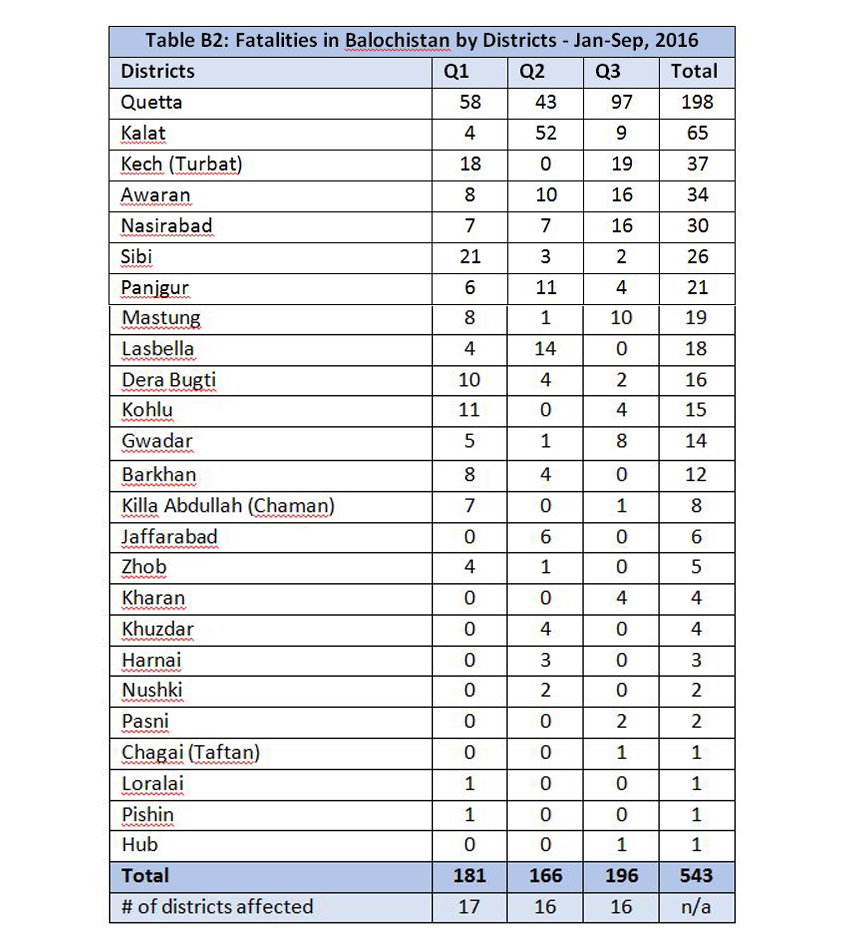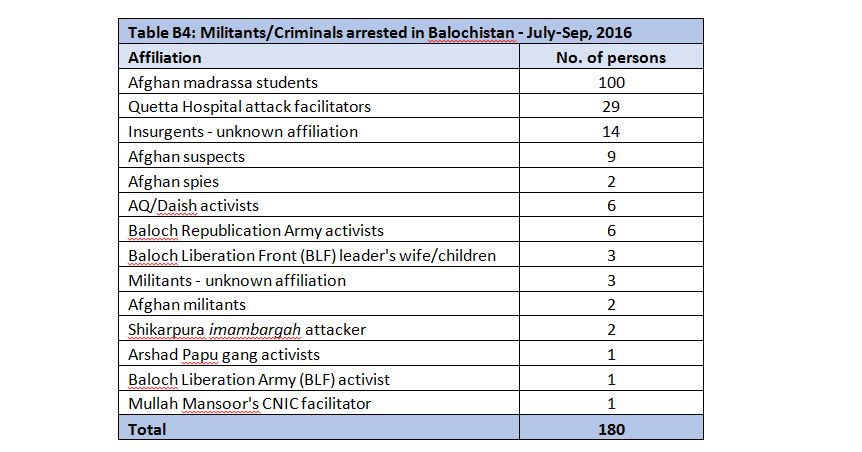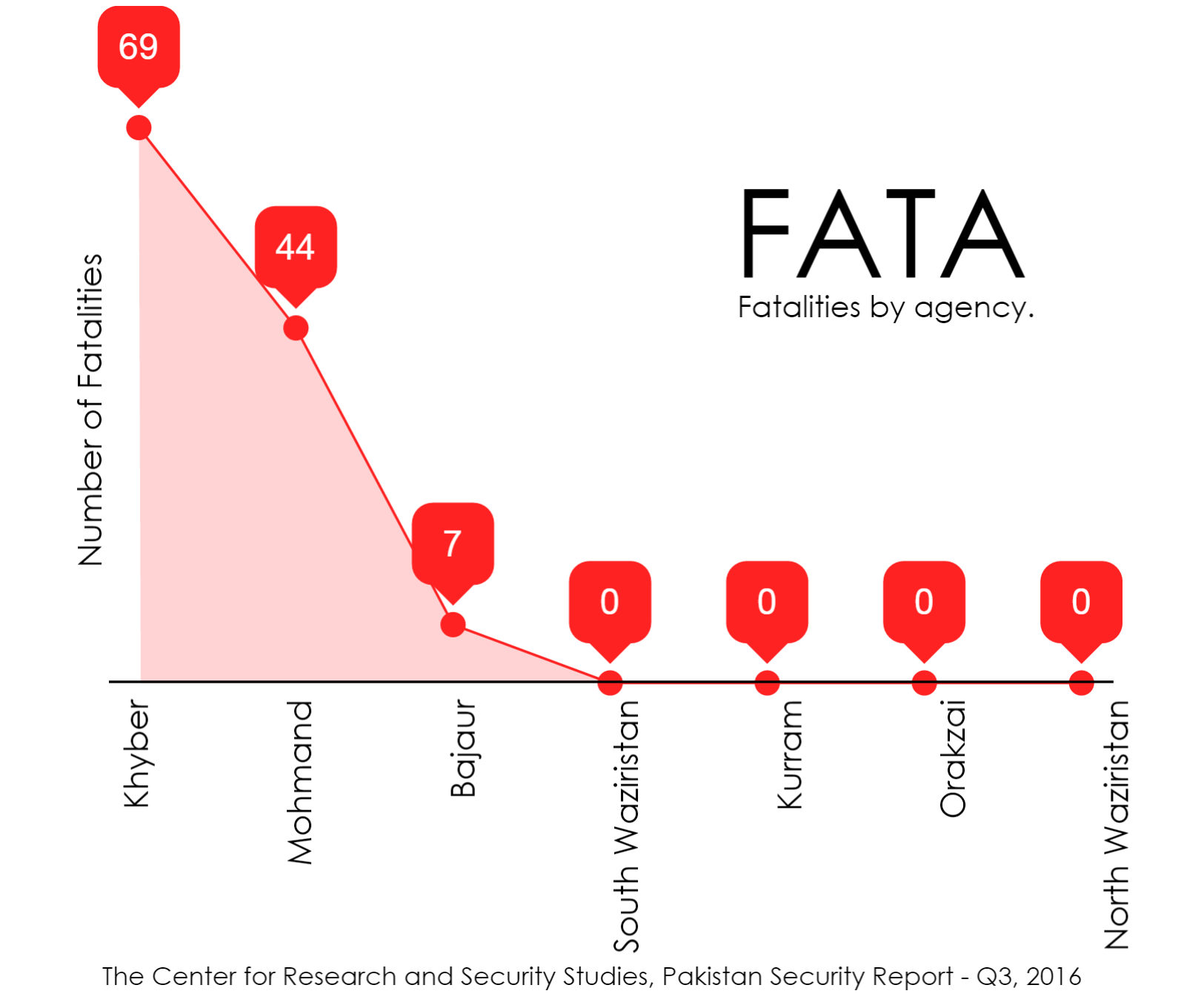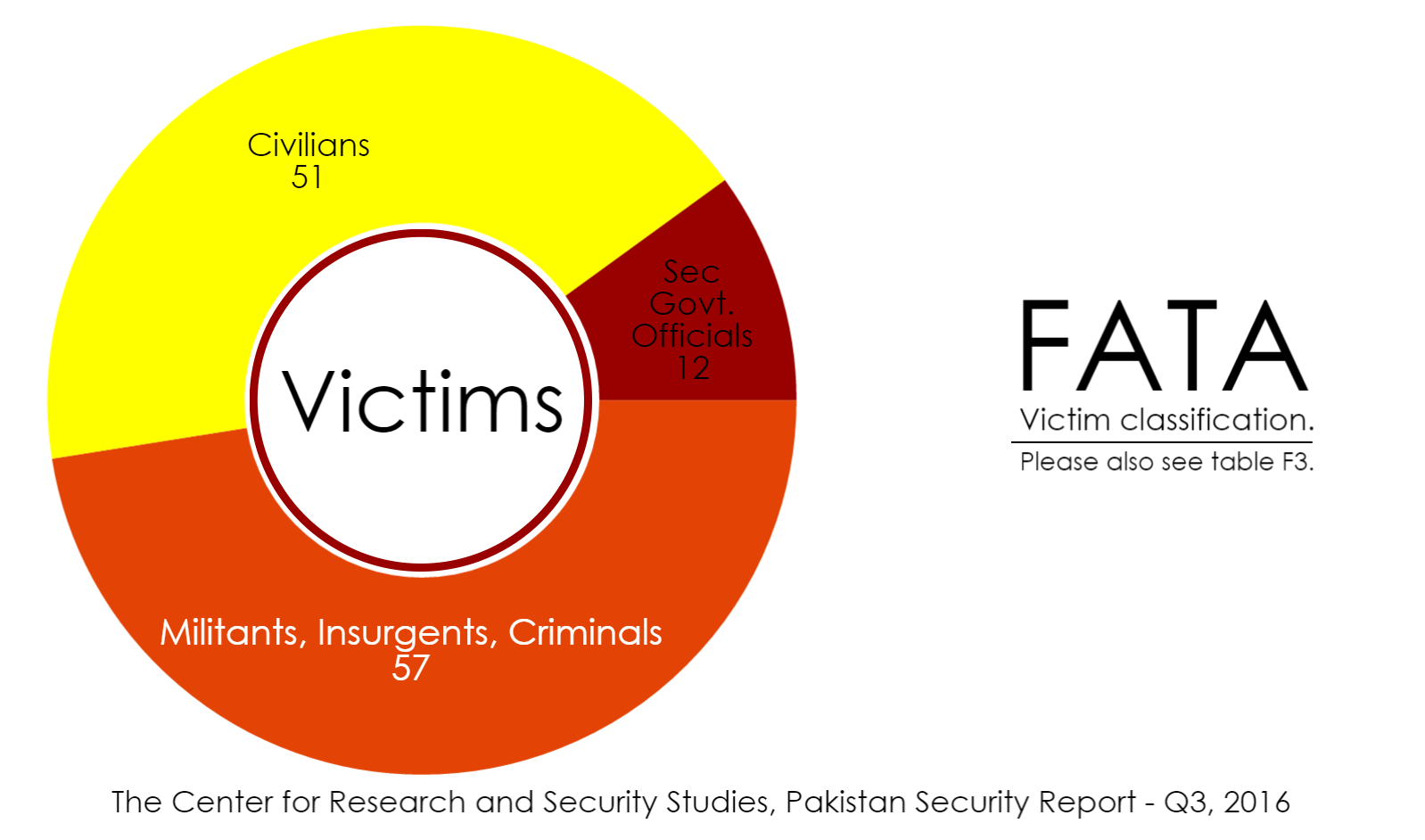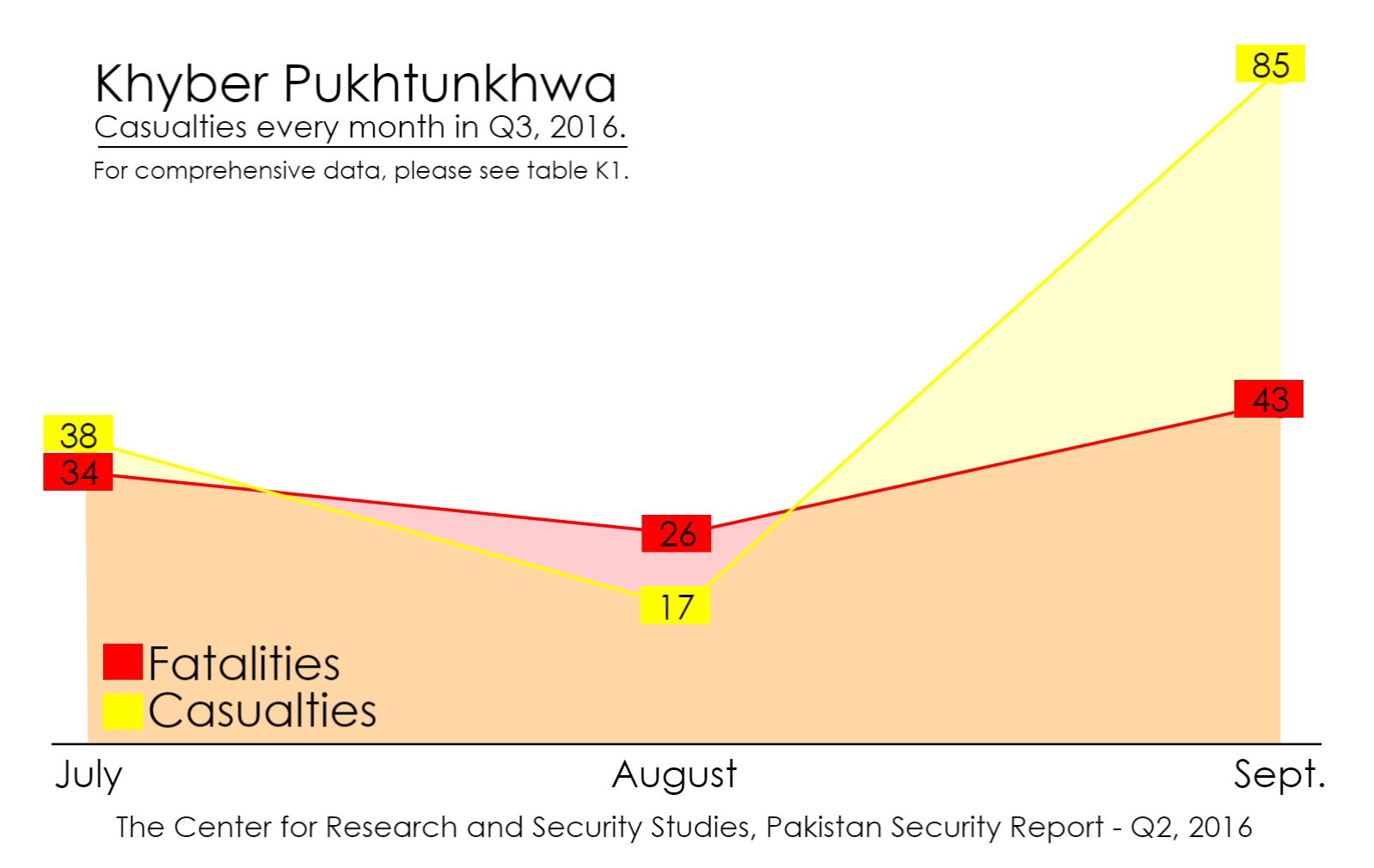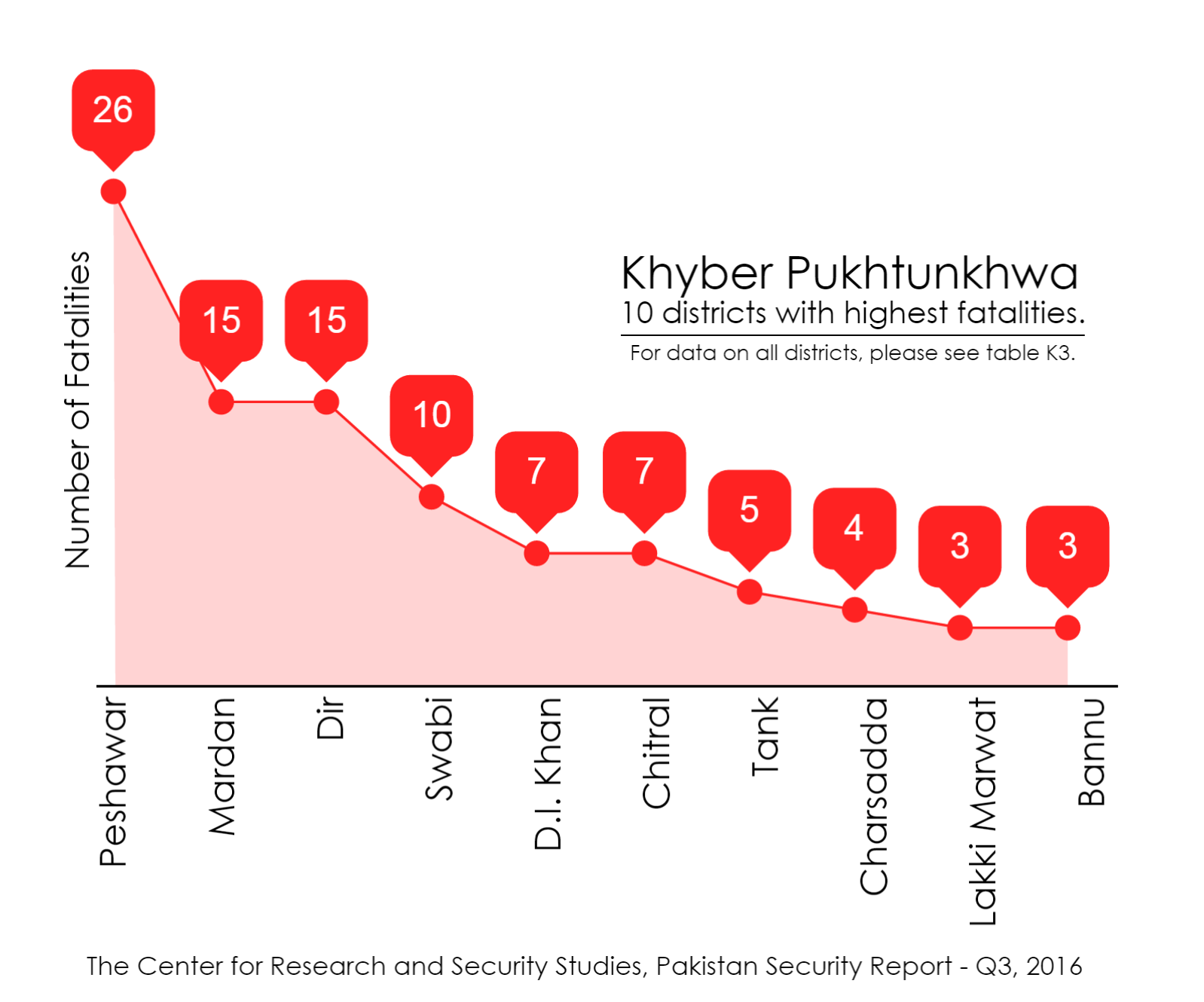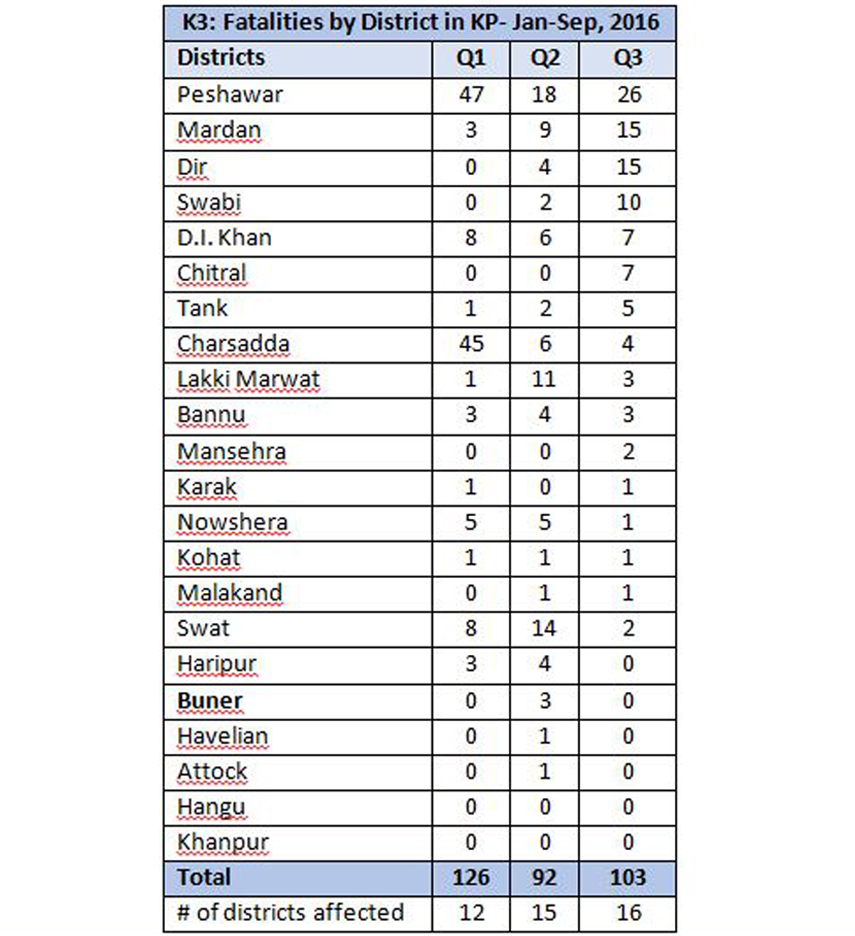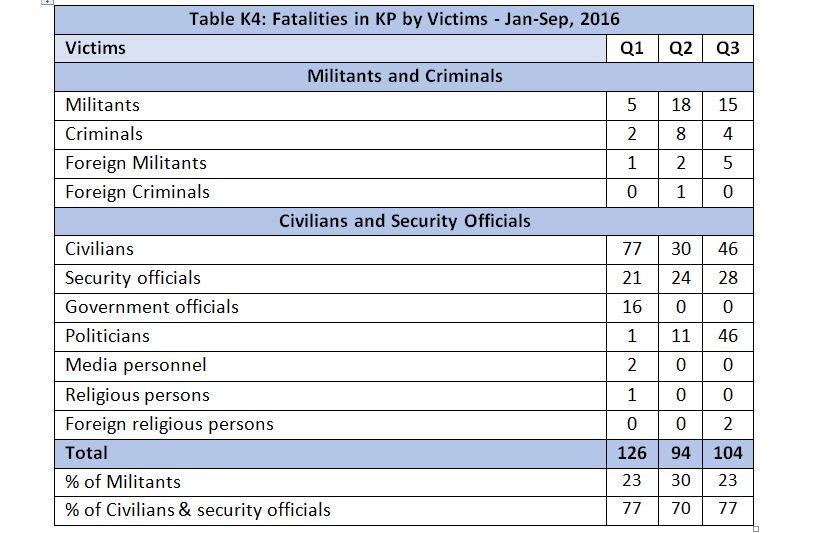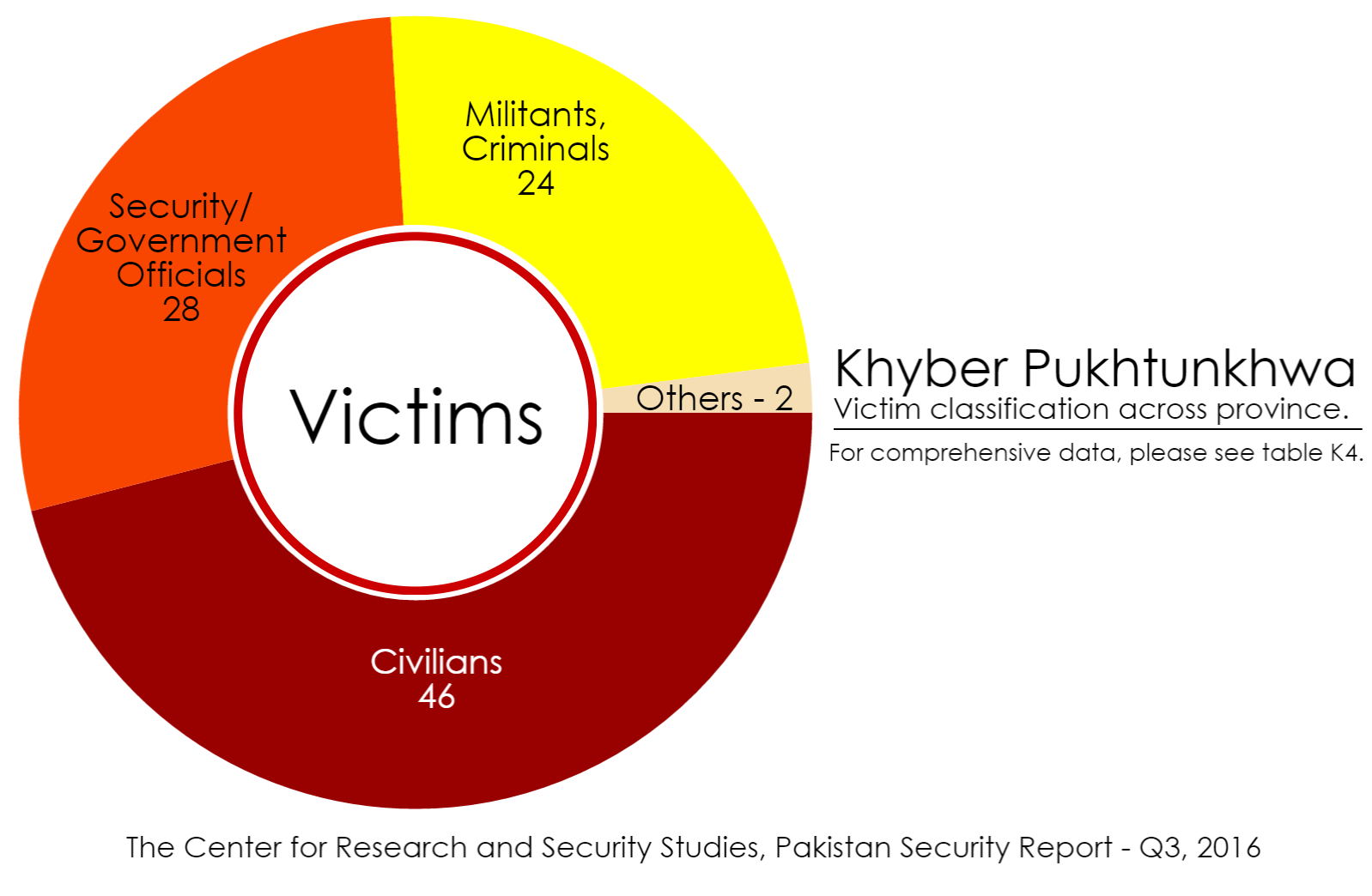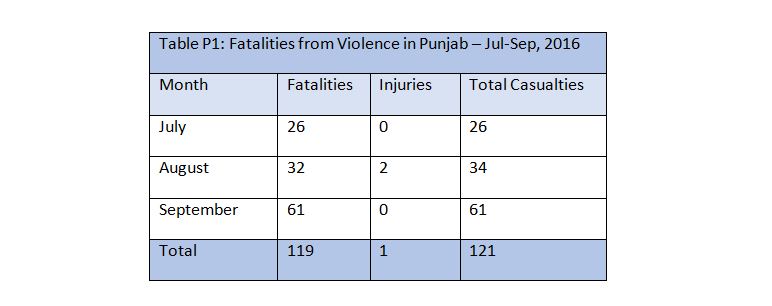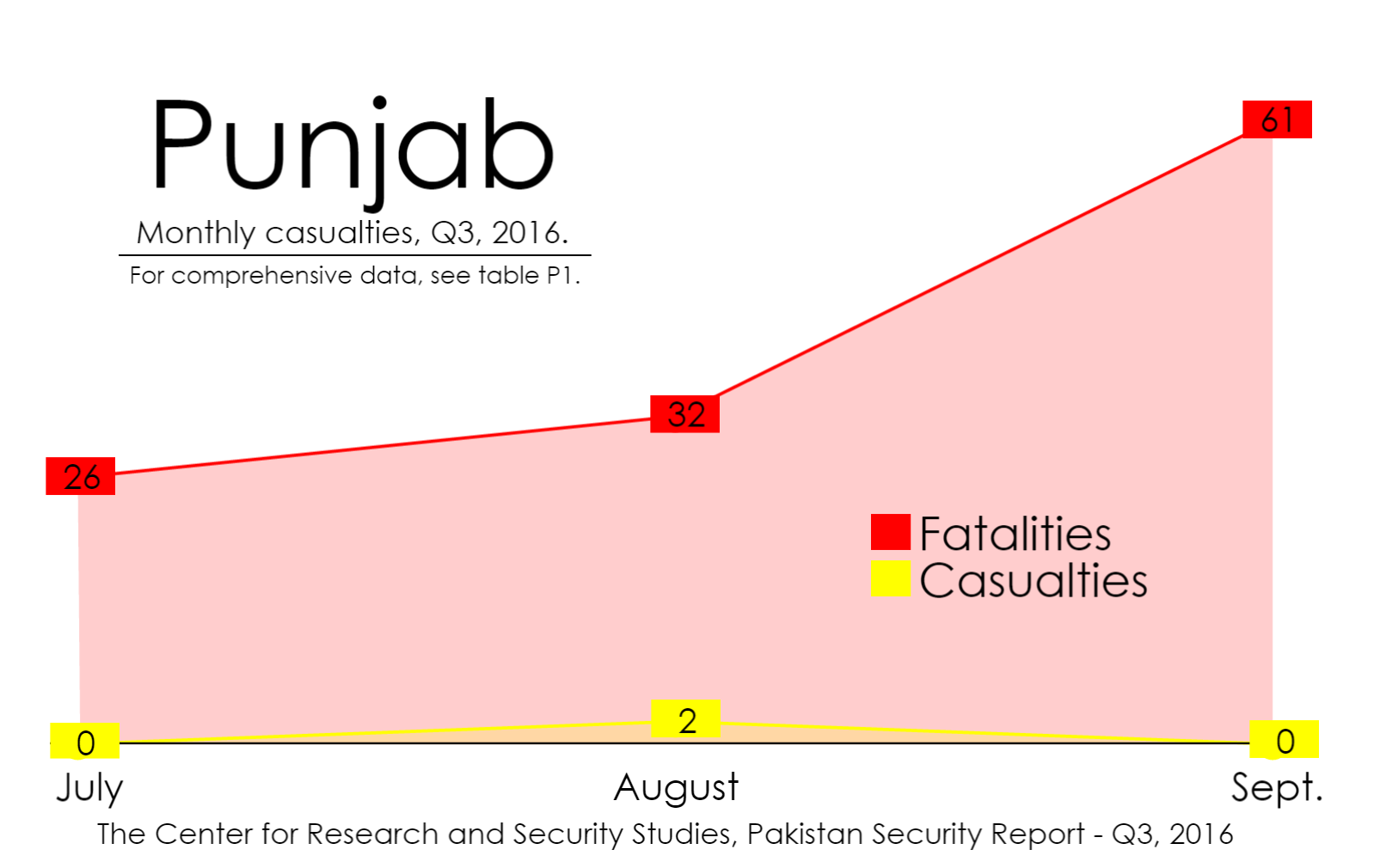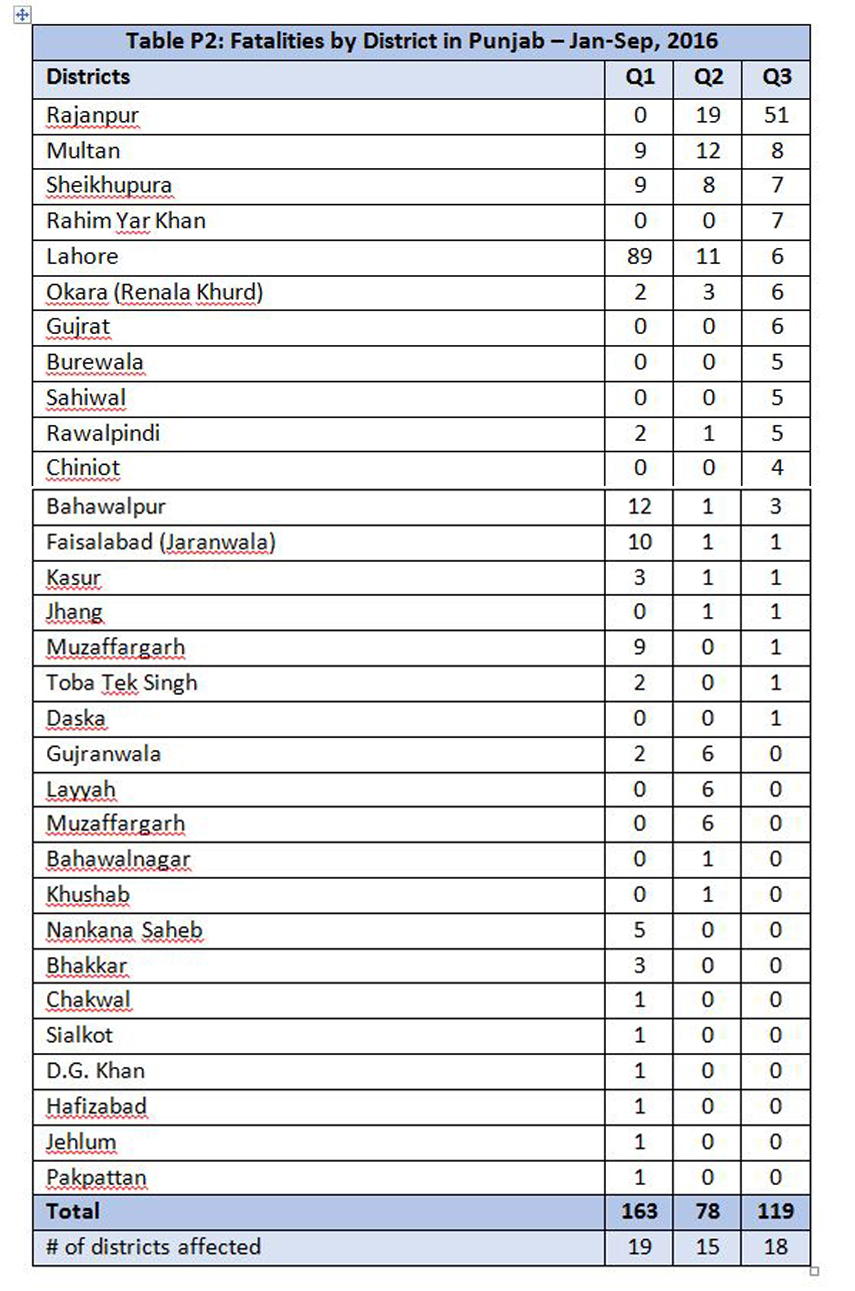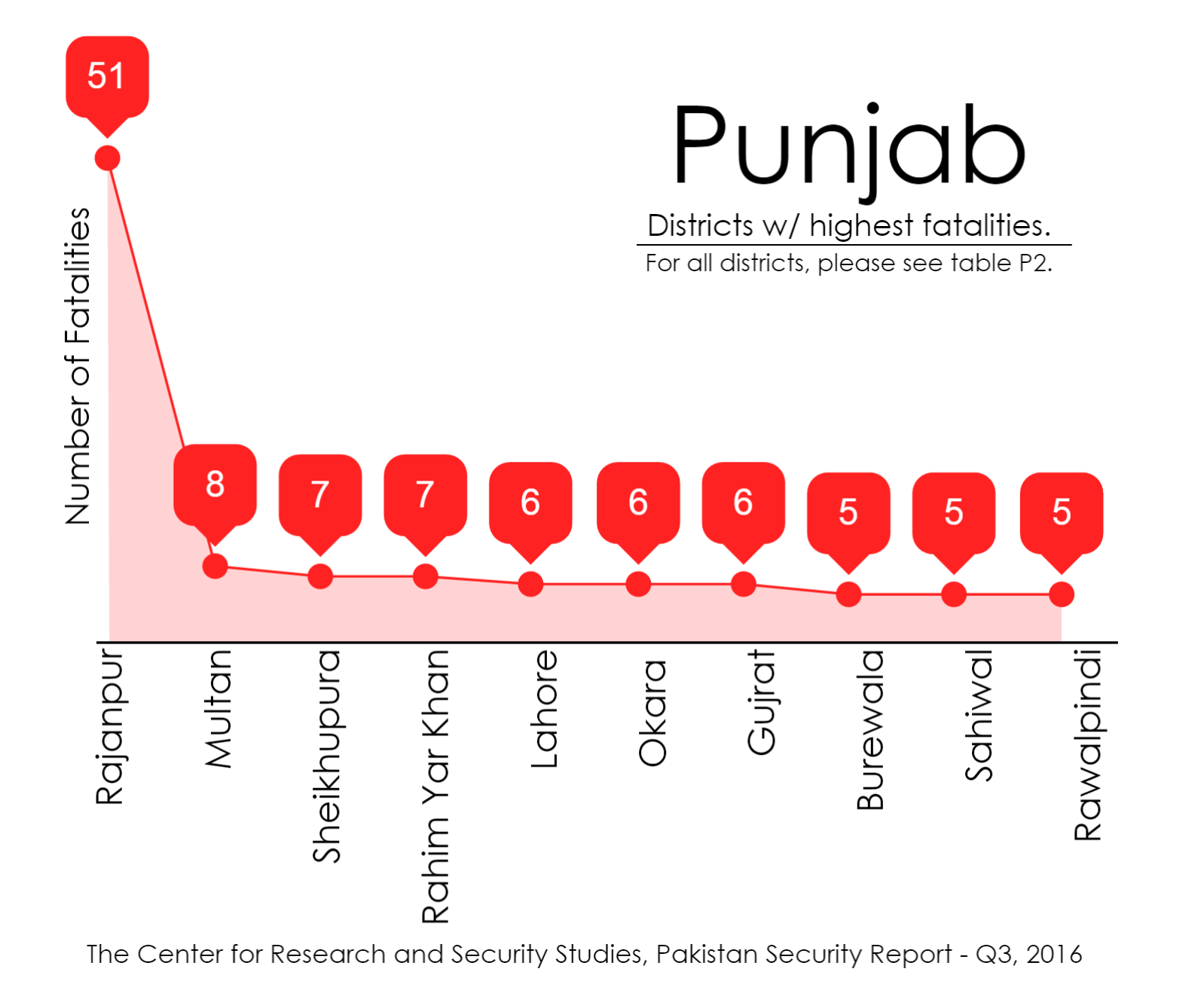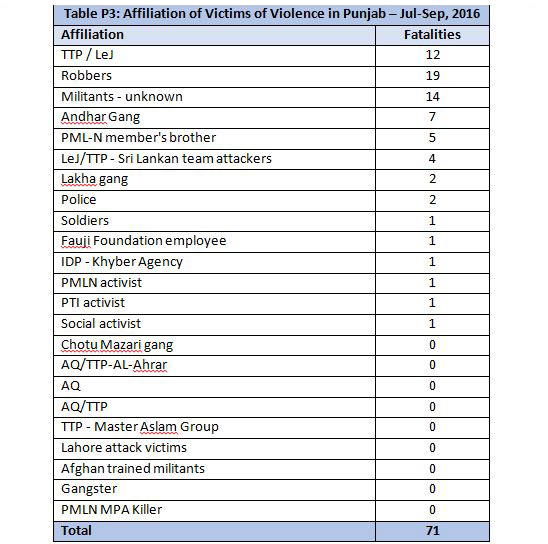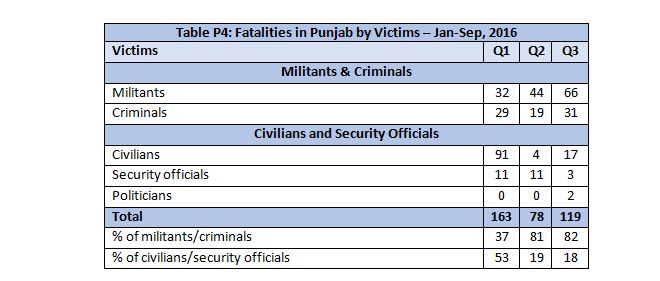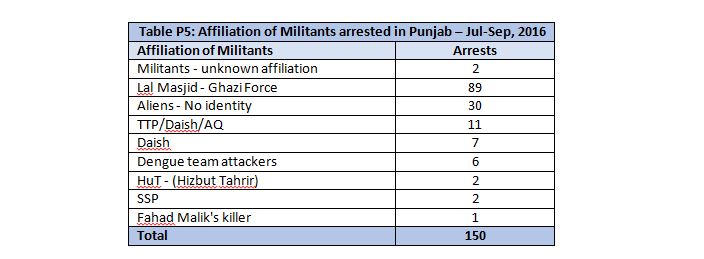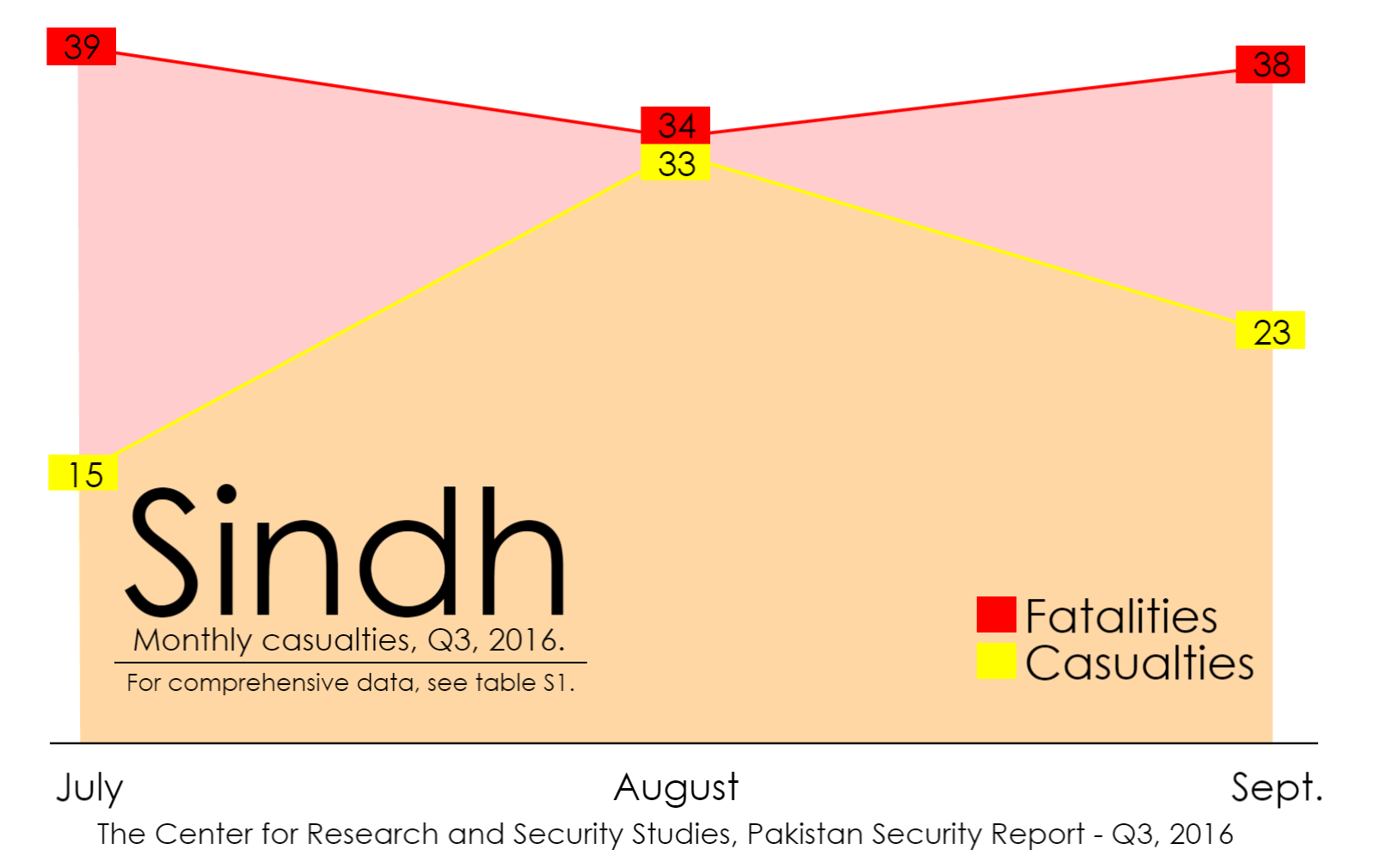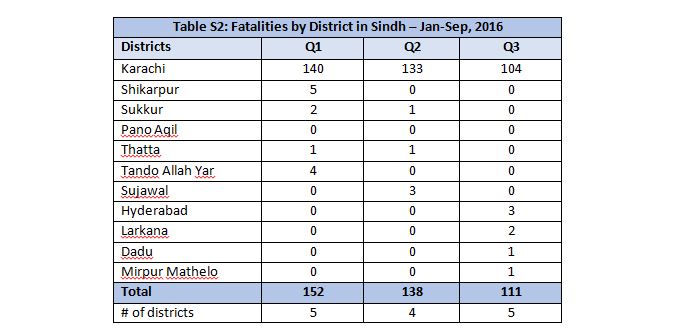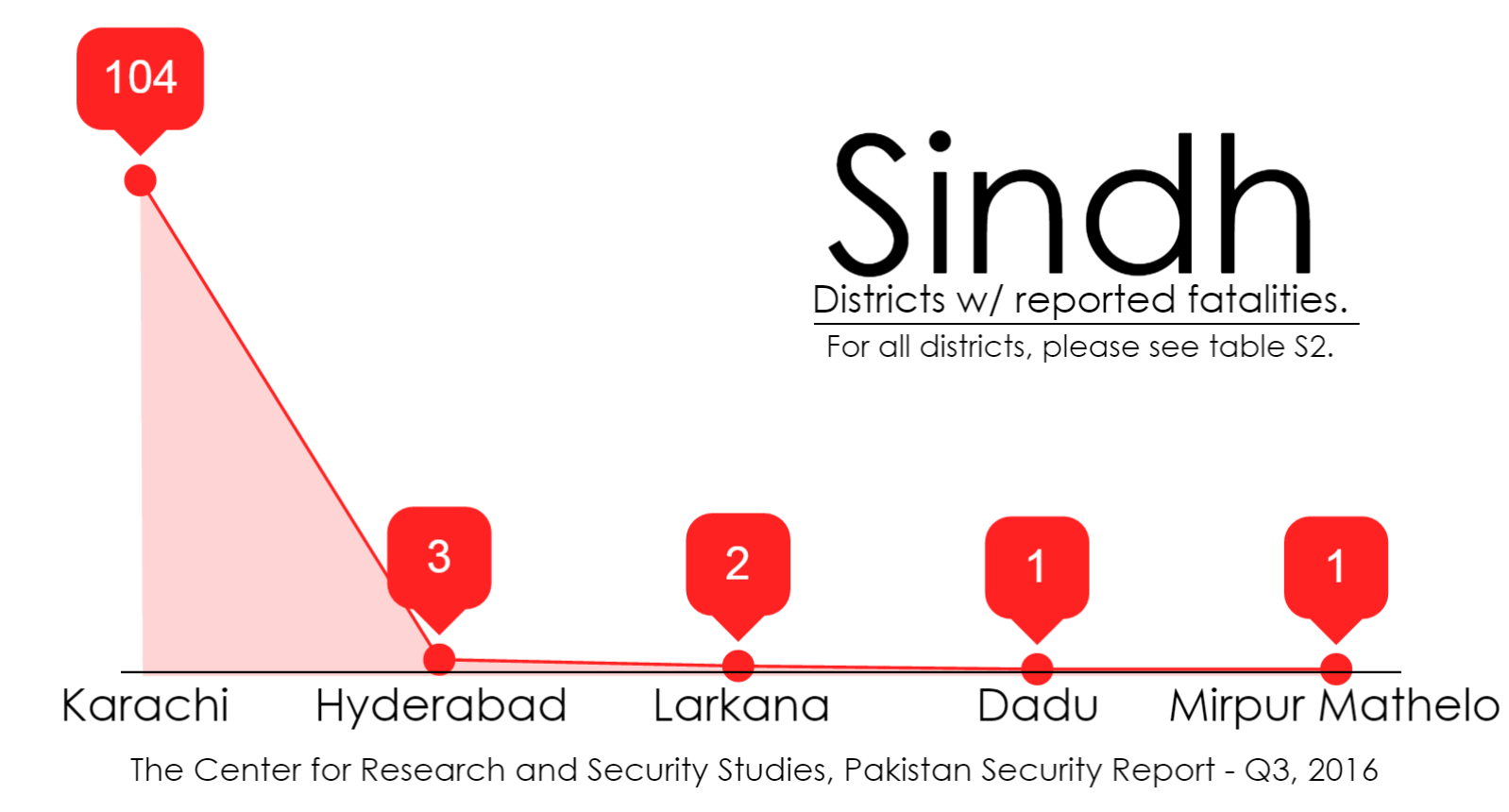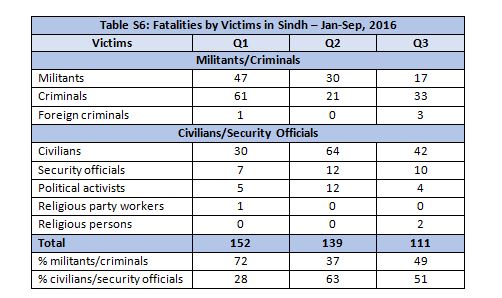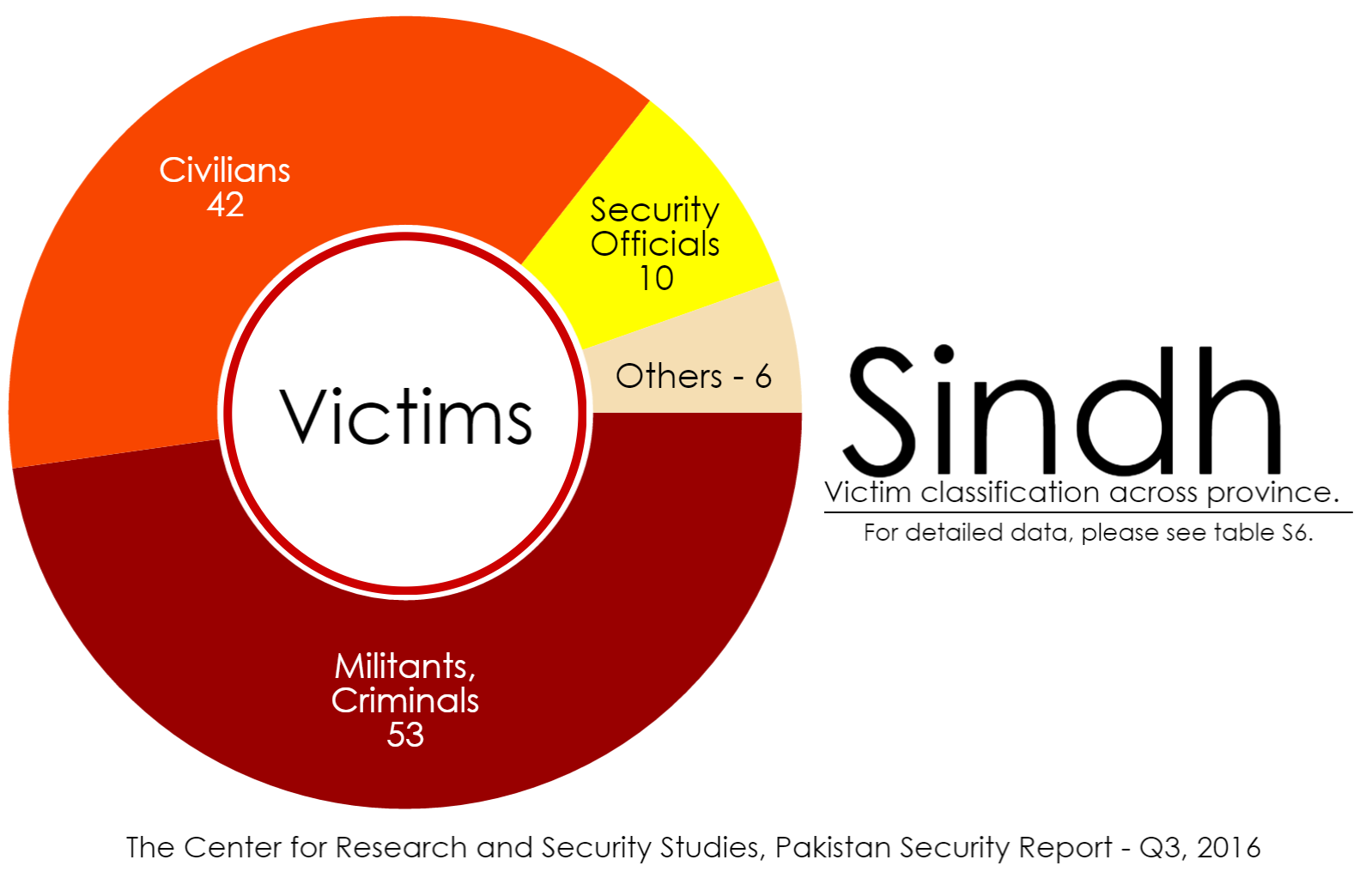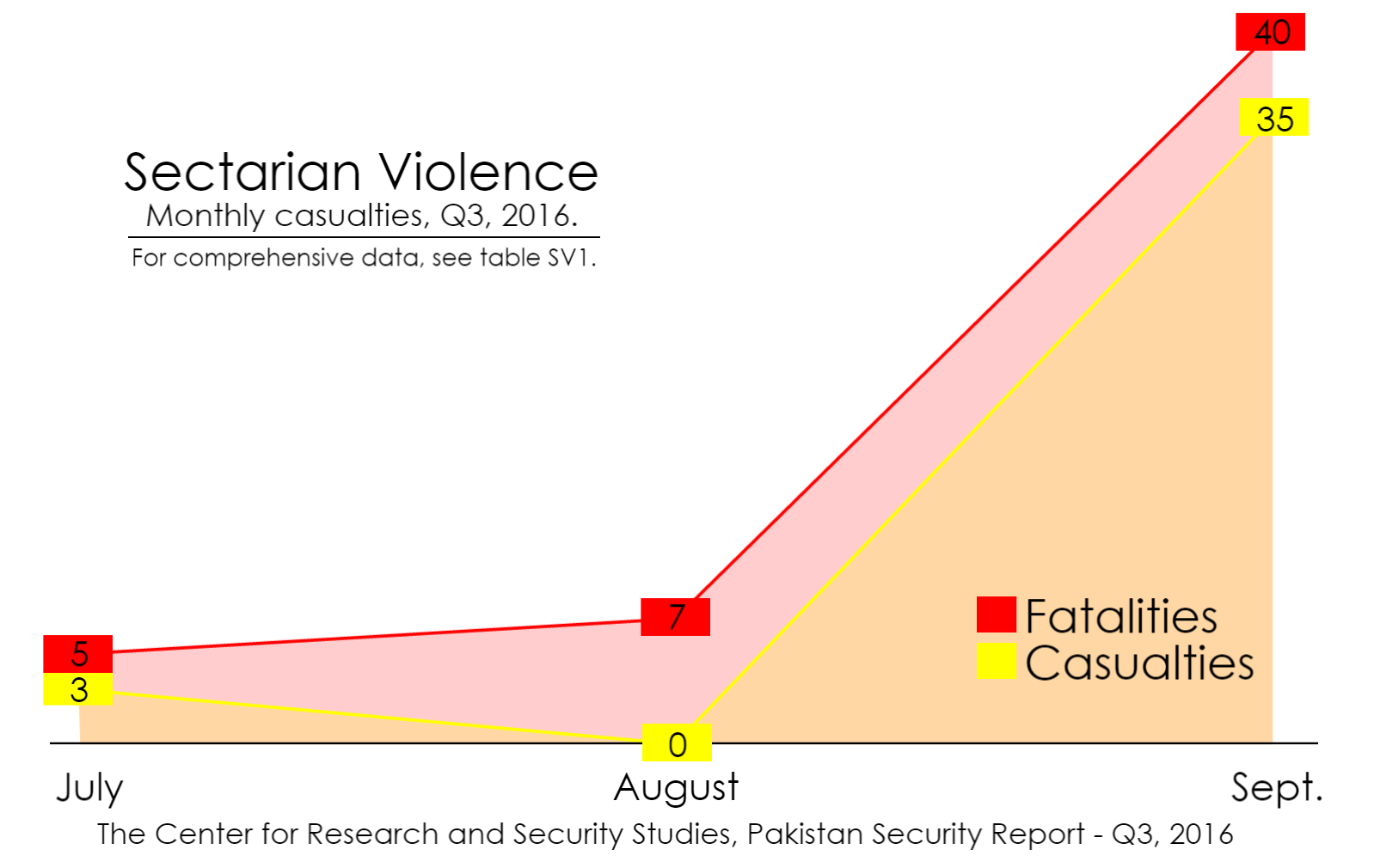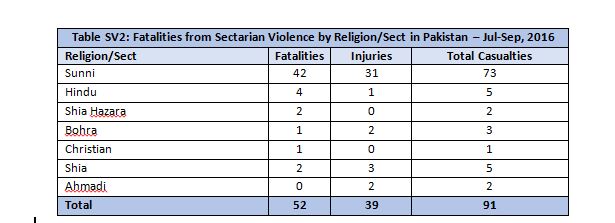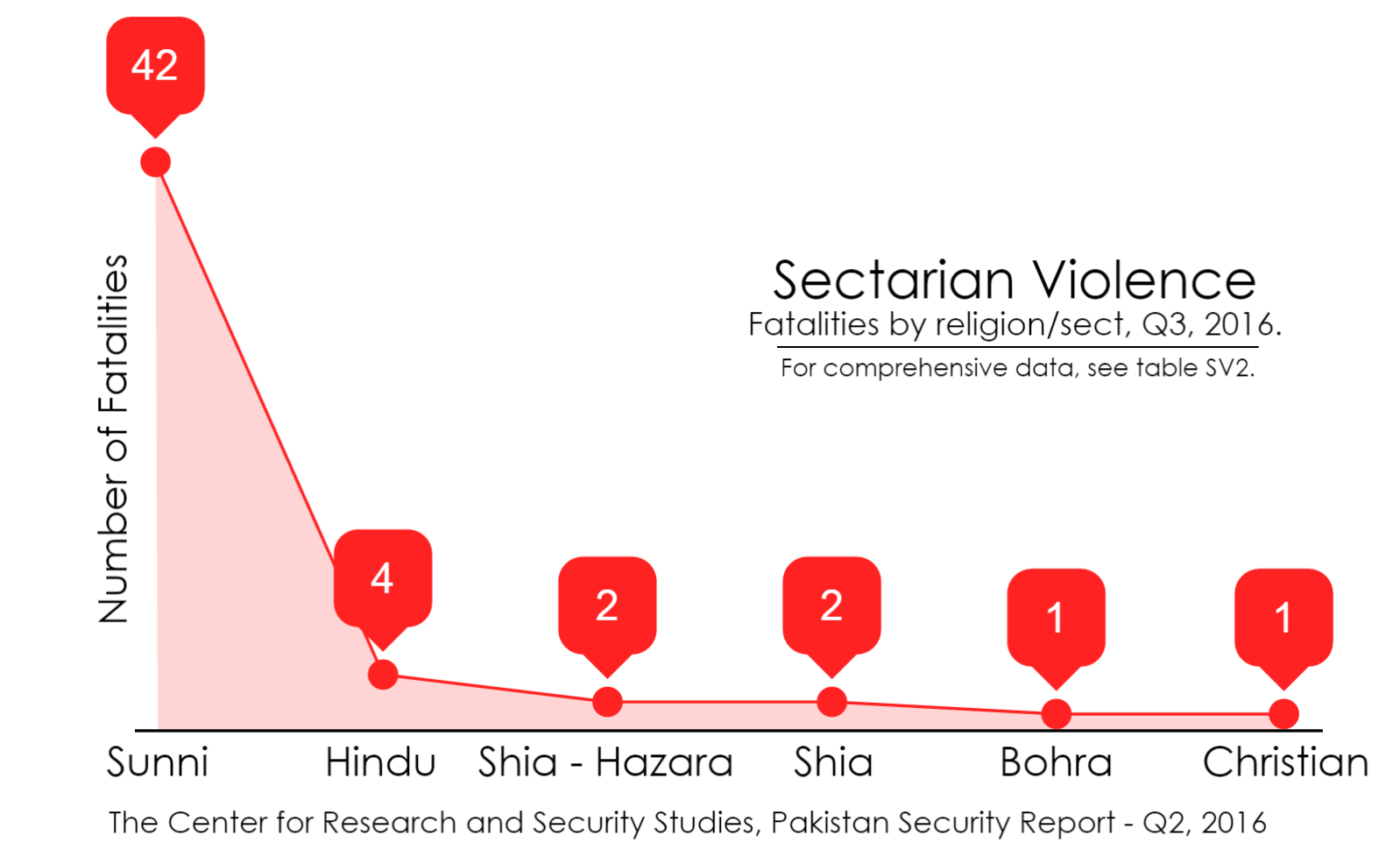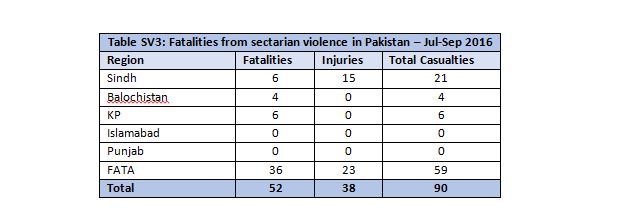Introduction
Pakistan experienced a 19.4% rise in the number of fatalities from violence from July to September, when compared with the last quarter. The most affected province was Balochistan, followed by FATA, Punjab, Sindh and Khyber Pakhtunkhwa, respectively, in terms of the number of casualties suffered from violence.
FATA observed a 90.5% rise in fatalities from violence-related activities this quarter while Punjab recorded a 52% increase when compared with the last quarter. However, it must be said that Punjab remains one of the least affected units in the federation. This quarter also witnessed continuous operations being carried out in various districts of Punjab in an attempt to preempt any terrorist activities as well as locating and arresting various gangs and banned outfits in the province. Sindh, on the other hand, observed a reduction in fatalities from violence-related activities.
In Khyber Pakhtunkhwa, despite the introduction of the KP Police Ordinance 2016, the efficiency of the law enforcement agencies did not improve. In fact, there were more civilian and security officials’ casualties reported from the province than those of militants’. While the Pakistan Army had claimed that the threat of terrorism had been mitigated to a great extent, this did not show in the data gathered between July and September. Due to the rising count of civilian casualties in Khyber Pakhtunkhwa in this quarter particularly, the Army decided to launch a military operation in the Khyber Agency in August against insurgents and militants still hiding and active near the border areas.
Pakistan has faced both external and internal security threats in these months, with India on the eastern border threatening to isolate Pakistan regionally by branding it the “mothership of terrorism”, and even withdrawing from the Pakistan-hosted 19th SAARC summit, and Afghanistan on the western border closing border trade with Pakistan a third time this year. Several Indian and Afghan spies were also arrested by the law enforcement agencies between July and September.
To assess and evaluate what new challenges and threats are being faced by the country, this report makes use of the national print and electronic media sources. CRSS endeavors to ensure that the data is as accurate as possible within the available resources. However, it does not rule out errors and omissions, which are always a possibility in such public-source statistical work. Such mistakes, nevertheless, do not grossly affect the overall outcome and conclusions of this report. It must also be said that this work cannot take into account incidents of violence-related fatalities and casualties that go unreported.
Readers can approach CRSS for information related to this report. Alternately, you may send your queries to mail@crss.pk, directly to Mohammad Nafees, Senior Research Fellow, CRSS – the author of the report (mohammad.nafees@yahoo.com), or Zeeshan Salahuddin, Senior Research Fellow (zeeshan@crss.pk) – the editor. CRSS Research Associate Sitwat Bokhari also helped edit the report and contributed to this executive summary.
Overall Situation in Pakistan
Pakistan lost 651 persons to violence during third quarter, July-September, (henceforth Q3) of this year, with 441 people that sustained injuries. This is a 19.4% increase in number of fatalities when compared with the last quarter. From January to September 2016, the total casualties stand at 3,317 (2,061 dead and 1,256 injured) as reflected in table 01 below:
A visual representation of the fatalities from violence for the last nine months shows that after a big dip in violence observed between April and July, a sudden surge occurred in the last two months. This compels security analysts to question the claims made by the government of its achievements in quelling the menace of terrorism in the country.
On the provincial level, Balochistan suffered the highest loss of human life to violence during Q3 (table 02). Despite concluding Operation Zarb-e-Azb in FATA, the rise in militancy forced the army to carry out some air raids in Khyber Agency, contributing to the second highest number of fatalities after Balochistan.
Security operations that include air raids, ground operations, and encounters were the highest causes of fatalities not only during Q3 but during Q1 and Q2 as well, leaving 251 outlaws dead this quarter (table 03). Target killings, suicide attacks, and militant attacks were the next highest contributors to human losses (313 cumulatively) recorded during Q3. There are three incidents of violence where external threats were at work. Six persons lost their lives when the Pakistani militants hiding in Afghanistan attacked the army check posts in the border areas of FATA. On the western front, three persons fell victim to cross border firing from India, and one was the victim of a rocket fired from the Iranian Border Forces which landed in Balochistan.
The methods used to carry out violence in the country varied from gun violence to rocket attacks and from bombs/landmines to suicide explosions. Table 04 below identifies what kinds of hardware were used to inflict casualties by the criminals/militants as well as statistics on victims. As reflected in the table below, 63 dead bodies were found dumped.
An overall assessment of the security situation in the country reveals an anomalous upsurge. However, this is just one quarter’s data and the situation could improve again. Unless this is a recurring pattern over successive quarters, it would be unfair to claim this as a failure of the anti-terror efforts in the country. Proportionally speaking, from a fatality rate of roughly 50% recorded for civil and military victims of violence during the last quarter, the figure went up to around 60% in Q3 – a 10% rise from previous month (Table 05).
Balochistan
Balochistan was worst affected by violence for the second straight quarter.
At the district level, Quetta, Kalat, Kech, Awaran, and Nasirabad were hit the hardest by violence during this year (Q1-Q3, 2016). The biggest sources of violence were suicide attacks, target killings, and other forms of terrorism. Balochistan also suffered one of the country’s worst attacks, when a suicide attack at the Civil Hospital in Quetta killed 73 persons, a vast majority of whom were lawyers.
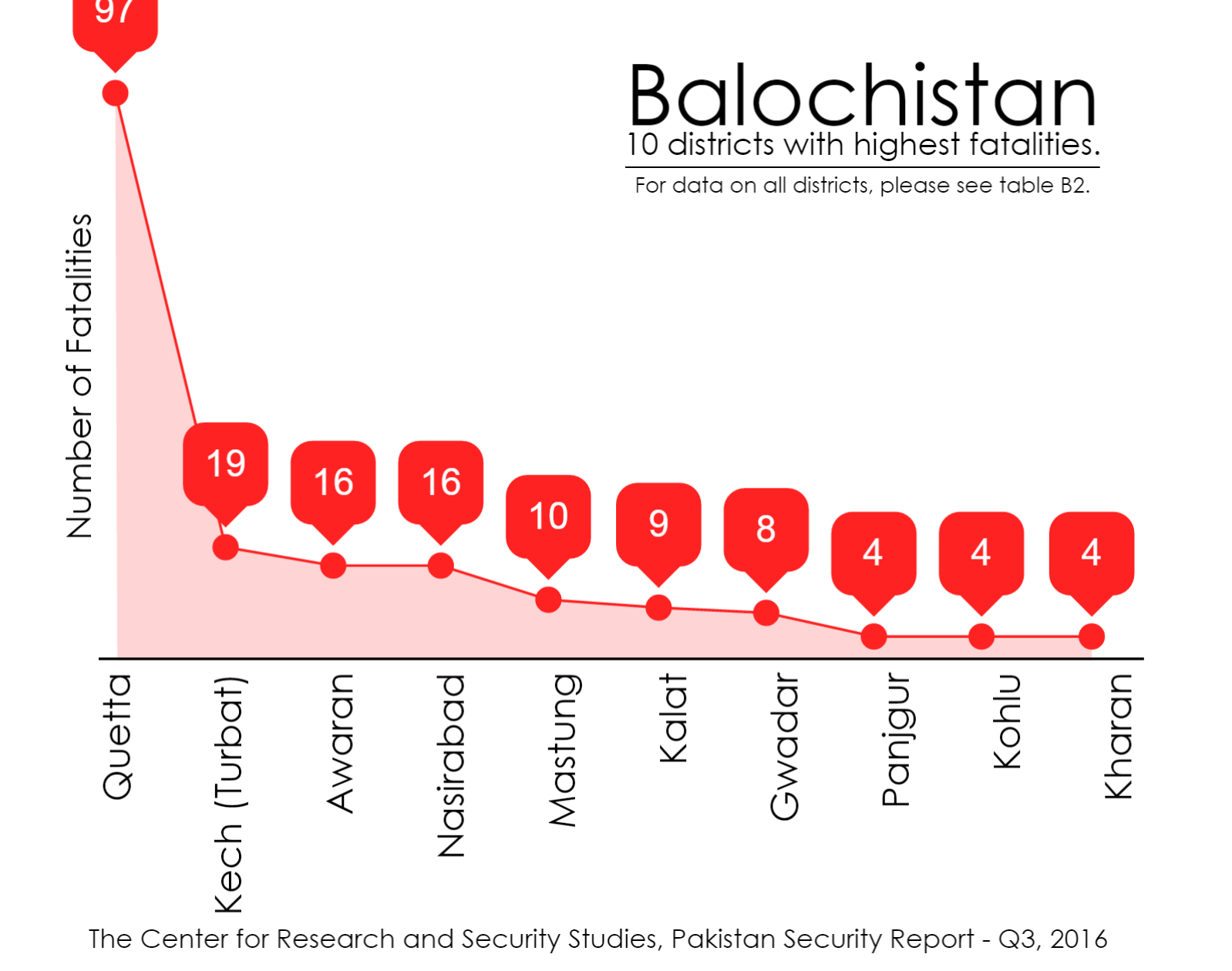 Civilians and military personnel fatalities accounted for 50% of total fatalities in Balochistan during Q1 and Q2. Civilian fatalities went up to 133 in Q3 from 59 in Q2 while security officials’ fatalities dropped from 21 in Q2 to 17 in Q3 (Table B3).
Civilians and military personnel fatalities accounted for 50% of total fatalities in Balochistan during Q1 and Q2. Civilian fatalities went up to 133 in Q3 from 59 in Q2 while security officials’ fatalities dropped from 21 in Q2 to 17 in Q3 (Table B3).
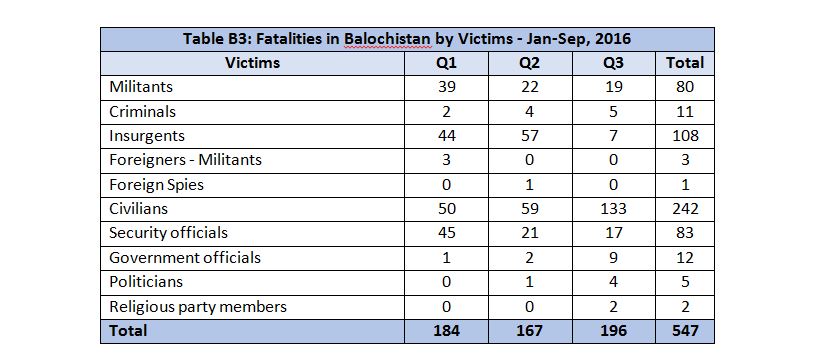
A number of militants and their facilitators were arrested in Balochistan during this quarter. The persons arrested can be divided in two categories – local and foreign nationals. Among the foreign nationals were Afghan madrassa students with no valid documents (100), Afghan suspects (9), alleged Afghan militants (2), suspected Afghan spies (2), and alleged Afghan criminals (1). The Pakistani nationals belonged to banned militant and insurgent organizations and some of them were accused as facilitators to the militants who carried out the attack on lawyers at the Civil Hospital in Quetta and to suicide bombers for their operation at an imambargah in Shikarpur. A tribal elder who attested CNIC of the Afghan Taliban Chief, Mullah Mansur, was also arrested from Chaman in Balochistan. Despite this progress by security and law enforcement agencies, Balochistan remained the province most affected by violence in Q3.
FATA
FATA witnessed a sharp rise in fatalities from violence during Q3. The total number of casualties reached 177 (120 dead and 57 injured) which was at 80 (62 dead and 18 injured) in Q2 (table F1). This proved to be against the assessment of the security agencies that the menace of terrorism had been curbed to a great extent. Based on this assumption, the army had been planning to carry out a large-scale combing operation outside FATA. The sudden rise in militant attacks across the country, however, compelled the government to change their decision and focus on seeking out the militants still hiding and active in the border regions of FATA.
During August and September of this year, Pakistan Air Force carried out several air raids in Rajgal area of Khyber Agency where it targeted 51 militants. A week after the last air raid on September 10, a suicide attack took place in Mohmand Agency which killed 36 persons during prayers at a mosque, many of whom were teenagers. Tehreek-e-Taliban’s Jamaat-ul-Ahrar claimed the responsibility for this attack. On August 27, seven unidentifiable bullet-riddled dead bodies were discovered in Khyber Agency and on September 30, one mutilated body of a 16 year old boy who had been missing was found in Mohmand Agency. On September 26, Afghan militants began firing at Pakistani check posts in Mohmand and Bajaur agencies near the Pak-Afghan border. Pakistani troops responded in retaliation to the heavy shelling whereupon the Afghan militant’s firing stopped. No security forces’ casualties were reported.
Out of the six agencies in FATA, three reported incidents of violence during Q3. The most affected of these were Khyber and Mohmand Agencies due to the militancy and counter-militancy operations (table F2). The region of North Waziristan, which was once considered the stronghold of hardcore militants and beyond the access of any law enforcement agencies, appeared to have been brought under control after the conclusion of Operation Zarb-e-Azb.
The law and order situation in FATA also witnessed a gradual deterioration during this year (Jan-Sep). The percentage of civil and military victims of violence continued increasing from 13% in Q1, to 30% in Q2 and 52% in Q3, raising questions about the claim of the security agencies that the militancy has been brought under control in the overall FATA region (table F3).
The reason for higher number of injuries lies in the methods of violence used in the province. The incidents of suicide attacks, IEDs and bomb explosions have been more frequent in KP than any other region of the country. As shown in table K2, KP had one suicide attack, 11 incidents of IED explosions, and 8 bomb explosions during this quarter where the number of injured persons was 121 while 29 fatalities were reported. Eight dead bodies, most of them mutilated beyond recognition, were also discovered from different locations in the province during this quarter.
The districts of Peshawar, Mardan, Dir, and Swabi suffered a high numbers of fatalities. In Mardan, a suicide attack at the District Court of the city made headlines in national newspapers as three policemen lost their lives in a confrontation with the suicide bomber. This was the second suicide attack in the country where the legal fraternity was targeted (the previous attack on lawyers was in Quetta). Militants from Afghanistan also carried out cross-border attacks in Chitral leaving two persons of Kalash origins dead and stole 2,500 of their goats. The security agencies later reported to have killed five militants from Afghanistan in Chitral. As noted in Table K3, violence has spread from 12 districts in Q1 to 16 districts in Q3.
The Tehreek-e-Taliban Pakistan (TTP), its splinter group Jamaat-ul-Ahrar (TTP-JA), Daish (also known as Islamic State) were the three banned outfits that claimed responsibility for the following attacks
The situation of law and order in Khyber Pakhtunkhwa remains unsatisfactory based on the number of fatalities from violence. As reflected in table K4 below, the fatalities of civilians and security officials remains between 70% and 77% of the total fatalities in the province this year. This shows that the militants and criminals were able to carry out their operations with much more ease in this province and the law enforcement agencies failed to counter them effectively. More foreign militants, all of them Afghan, were also found operating in KP in this quarter. So far in 2016, the security agencies in KP managed to eliminate 9 foreign militants and criminals from the province.
Although the policemen at the District Court in Mardan responded hastily and dedicatedly against the suicide bombers, the escape of 11 hardcore militants from Mardan Jail nearly two months before this incident raises questions about the efficiency and preparedness of the jail management. In fact, the nature of militants and criminals arrested in KP by law enforcement agencies (table K5) shows the extent of support and facilitation available to militants and the challenge it poses for the efficiency of law enforcement agencies. In the last three months, 11 facilitators of militants (unidentified) were arrested in KP in addition to those suspected of involvement in the terror attacks at the Army Public School (APS) and the Christian Colony in Peshawar. A foreign militant and a foreign spy, both Afghan, were also arrested during this period.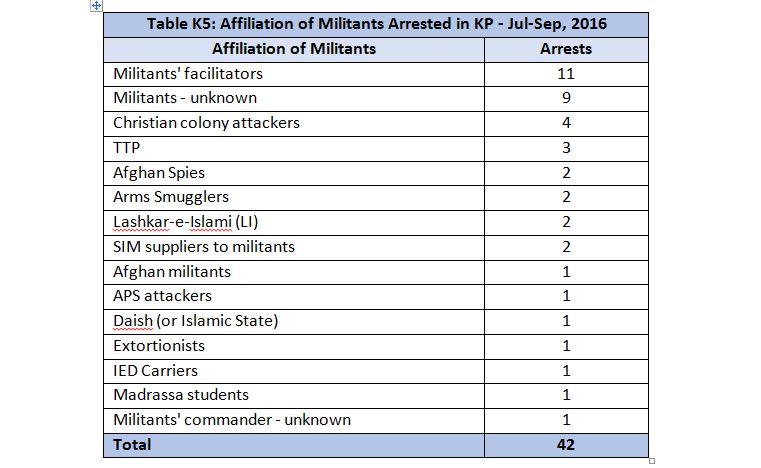 Punjab
Punjab
Punjab, the most populous province of the country, has been the most peaceful in this period in terms of the number of fatalities reported due to violence. During Q3, Punjab recorded 111 fatalities and two injuries (table P1). Looking graphically at the number of fatalities recorded in the province during the last nine months, a significantly downward trend in violence can be noticed from March through June. However, from July onward, an upward trend continues through the month of September, 2016.
As table P2 shows, Rajanpur had the highest number of fatalities during Q3. Multan, Sheikhupura, Lahore, Okara, Gujrat, and Rahim Yar Khan were the most affected with violence-related fatalities after Rajanpur. There were a number of districts that had suffered no fatalities during Q1 or Q2 while some that suffered none in Q3 but did in the previous two quarters.
Punjab is the only province where no incident of suicide or militant attacks, or any form of terrorist attack was reported during Q3. Target killing and robberies were two of the causes of fatalities in this province. However, they account for only 15% of the total fatalities. Most of the remaining fatalities were a result of security operations being carried out in different parts of the province, particularly in the tribal areas of Rajanpur. The district of Rajanpur constantly appeared in press reports during this quarter due to violence incurred by outlaws and the counter-operations carried out by the paramilitary Rangers.
Data on the affiliation of the victims of violence in Punjab highlights two types of victims; robbers and militants, with both known and unknown identities (table P3). The most prominent militants that were eliminated during security operations in Punjab were associated with TTP and Lashkar-e-Jhangvi (LeJ). On August 28, four accused terrorists ─ three of whom were charged with involvement in the 2009 attack on the Sri Lankan cricket team ─ were killed. They were identified as Zubair alias Naik Muhammad, Abdul Wahab, Adnan Arshad and Ateequr Rehman. As the mastermind of the attack on Sri Lankan team was reported to be the Chief of LeJ, it is assumed that these four terrorists killed in the operation may be affiliated with LeJ as well.
Robbers and their gangs also remained the main focus of security operations though robbery-related fatalities in Punjab were not as high as they were in Sindh. Punjab witnessed 3 fatalities from robberies during Q3 while in Karachi, Sindh, the number of such fatalities was 15.
Compared with other provinces, the law and order situation in Punjab appears to be more than satisfactory seeing as how the number of fatalities of civilians and security officials has remained less than 20% of the total fatalities in the province in latter two quarters of this year (table P4). No other province has managed such a level of control on violence-related casualties of civilians and security officials.
No banned outfits claimed responsibility for any act of violence that took place in Punjab during this quarter. However, the security agencies arrested militants belonging to TTP, Daish, Hizbut Tahrir (HuT), Sipah-e-Sahaba Pakistan (SSP), and foreigners having no valid identity documents (table P5).
Casualties from violence in Sindh were reported to be 182 (111 dead and 71 injured) in Q3 (table S1). Since the Q1 of this year, a constant downward trend in violence has been noticeable in the province, particularly in Karachi (table S2). The causes of fatalities in Sindh were mostly associated with target killings (41), robberies (5), and counter-violence operations by security agencies (41).
Besides Karachi, other districts that suffered fatalities from violence during this quarter were Hyderabad, Larkana, Mirpur Mathelo, and Dadu. Most of the victims were outlaws that were killed in encounters with security agencies.
Encounters, gun violence, and dumping of dead bodies were the most common methods used for violence and counter-violence operations in Sindh. Two attempts at suicide attacks at an Eidgah and an Imambargah in Shikarpur were foiled by the policemen that were guarding the holy places. In the operation, 13 people, including 5 policemen, suffered injuries while a suicide bomber was arrested.
18 dead bodies were found, mostly in Lyari River, in Karachi. Incidents of robbery-related violence even resulted in public reactions that often took the form of lynching of the robbers that were caught red-handed. All in all, eleven robbers were lynched in the city during this quarter. Three of them were beaten to death, one was shot dead, and one was set on fire resulting in his death. Six were severely beaten by the mob. During robberies, the perpetrators also resorted to violence and killed 15 persons in Karachi.
Three bomb explosions also occurred in Sindh: one in Larkana, one in Hyderabad, and one in Badin, which left one dead and 20 injured. Sindhudesh Revolutionary Army (SRA) claimed responsibility for the bomb explosion in Larkana which had targeted a Rangers’ vehicle. Custodial deaths of three persons were also reported during this quarter, all of which occurred in Karachi. Two persons belonging to MQM, Mohammed Waheed and Mehmood Khan, were reported dead during treatment at the hospital while another person, identified as Qismat Nabi, was found dead in his prison cell. The police claimed that he took his own life and that he was found hanging in his cell by another prisoner.
Among the identifiable civilian and security official victims of violence in Sindh, the highest number was of policemen and MQM activists. A policeman, who confronted a suicide bomber in Shikarpur, died from injuries in addition to a traffic policeman. People belonging to minority communities were also targeted in acts of violence in Sindh which included 3 Hindus and one person from the Bohra community. The following table tallies the fatalities across a range of parameters, as it is near impossible to create hard classifications.
Among the fatalities of criminals and militants reported in Sindh, the highest numbers of fatalities were of robbers (16) followed by militants belonging to banned outfits such as TTP (8) and Lashkar-e-Jhangvi (7). All of these were killed in Karachi during police encounters that took place in Lyari, Sohrab Goth, Orangi, and Manghopir areas of the city. Three Afghan nationals found to be involved in robberies were also killed in a security operation in Karachi (table S5).
The law and order situation seems to have slightly improved in Sindh during this quarter when the percentage of fatalities of criminals and militants recorded are compared with the last quarter’s percentage. In Q2, 63% of the victims in the province were civilians and security officials. This quarter it came down to 51% though it was still higher than the percentage recorded in Q1 (table S6).
During security operations in this quarter, a large number of criminals, militants, and, political party activists suspected of having involvement in crimes were arrested. Political activists belonging to MQM and their affiliated criminal elements had the highest number among all those who were arrested during this quarter. Seven policemen were also arrested on charges of being involved in kidnapping. Outlaws from banned outfits, such as TTP, Lashkar-e-Jhangvi Al-Alami, SSP, were also arrested by security agencies from Korangi, Gulshan-e-Iqbal, and Manghopir areas of Karachi.
Besides local militants and criminals, some outlaws and spies, hailing from foreign countries, were also apprehended in Sindh. Three agents, belonging to the Indian spy agency Research and Analysis Wing RAW, were also arrested from the Lines area of Karachi, while two activists of a Sindhi nationalist organization named Jeay Sindh Muttahida Mahaz (JSMM). Noor Hassan Bhachho and Masroor Thebo, who were accused of having links with RAW were arrested from Hyderabad. A police official, SSP Irfan Baloch, claimed that these activists had launched attacks to sabotage the China-Pakistan Economic Corridor (CPEC) with funding from RAW.
 Sectarian Violence in the Country
Sectarian Violence in the Country
Sectarian violence in the country claimed the lives of 52 persons, leaving 38 persons injured during Q3, 2016. September was the worst in terms of sectarian violence (table SV1).
For the first time during this year, people belonging to the Sunni sect suffered more casualties due to sectarian violence than any other religious community in Pakistan (table SV2). Suicide bombers, trained and directed by banned militant outfits, mostly targeted religious congregations at mosques, imambargahs, and churches. On September 2, four armed terrorists trying to attack a Christian colony in Peshawar’s outskirts were killed during a stand-off with security forces. However, one Christian, Samuel Masih, was also killed and two soldiers and a policeman sustained injuries. During Eid prayers, a mosque and an imambargah were targeted by four suicide bombers in Shikarpur leaving one policeman dead and 12 injured. One of the suicide bombers was captured by the worshippers. Initial interrogation of the arrested attacker, Usman, revealed that the would-be bomber was a resident of Swat’s Qabal Tehsil and had studied in Karachi’s Abu Huraira seminary, police sources reported.
Another suicide attack on a mosque was reported from Mohmand agency on September 16, which left 36 persons dead and 23 injured. All attacks were claimed by Jamaat-ul-Ahrar, one of the splinter groups of TTP.
FATA, Sindh, Khyber Pakhtunkhwa and Balochistan suffered casualties from sectarian violence during this quarter. Punjab and the capital of the country, Islamabad, reported no sectarian incidents (table SV3).

